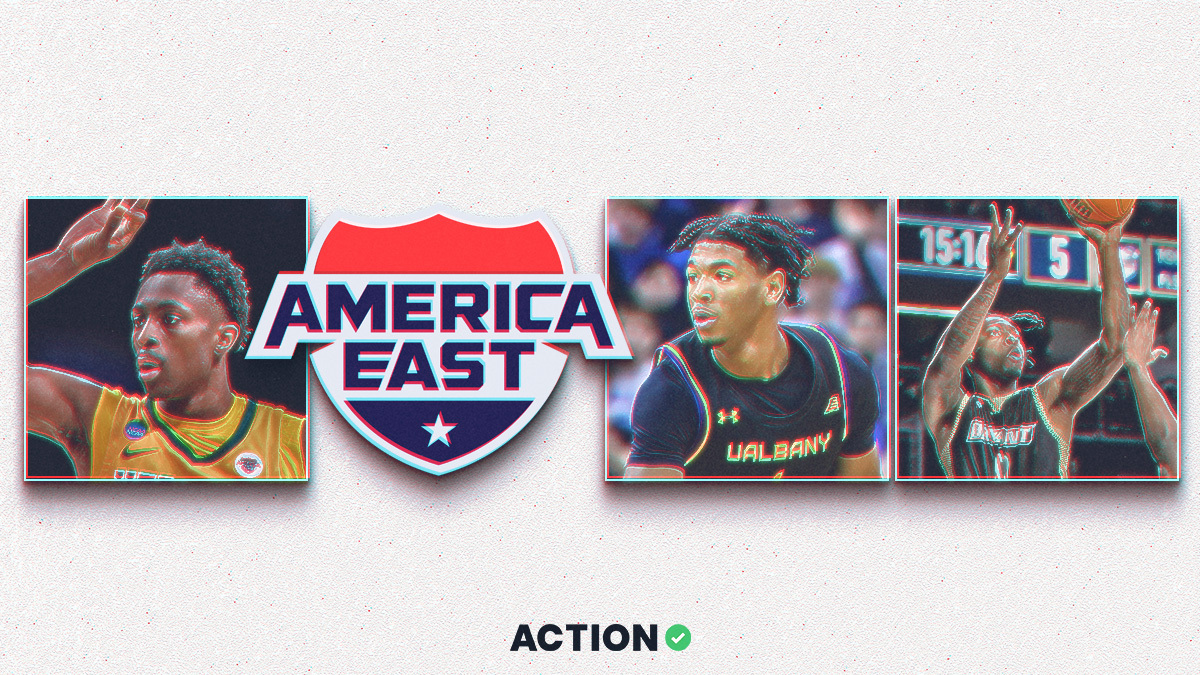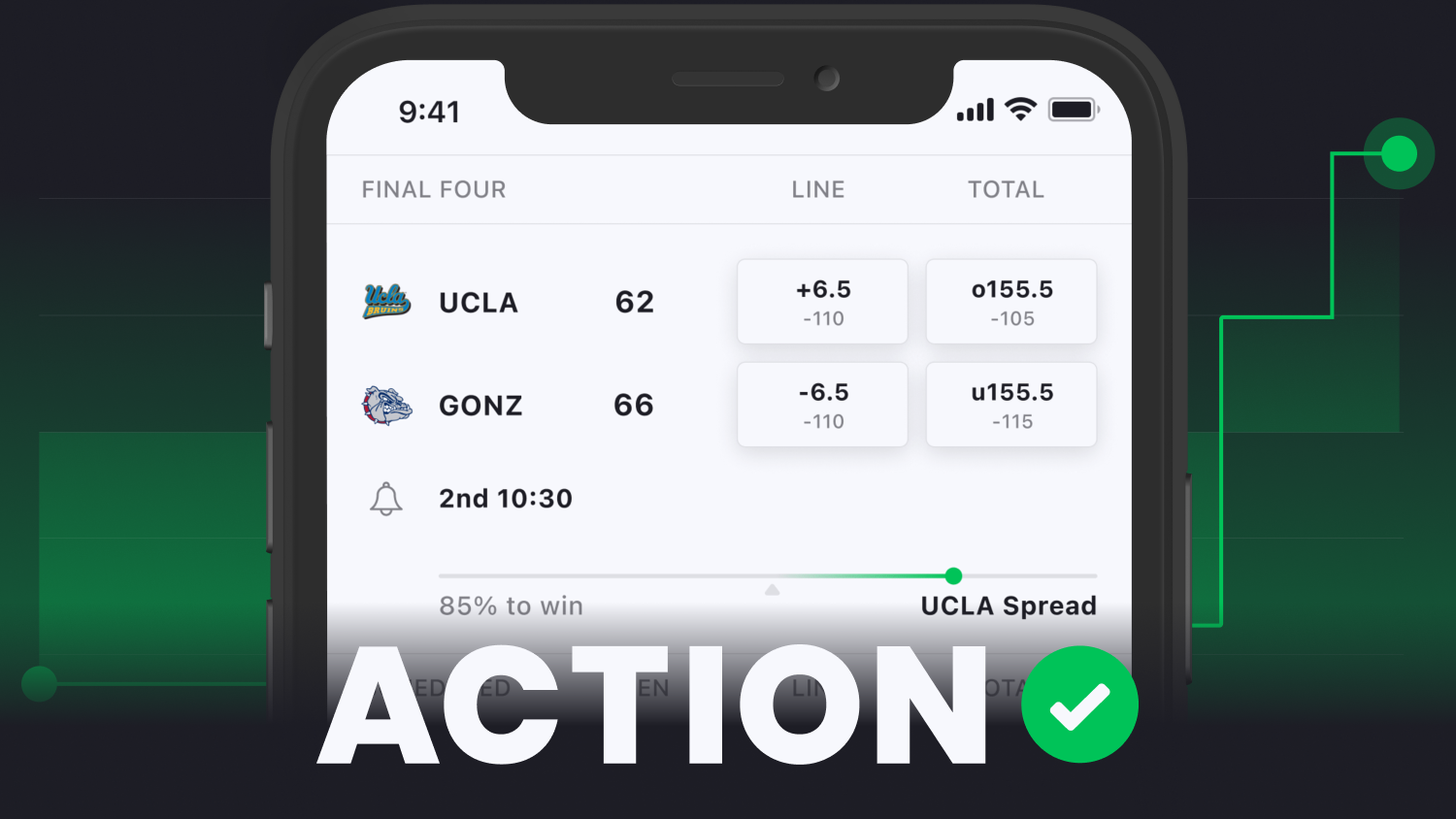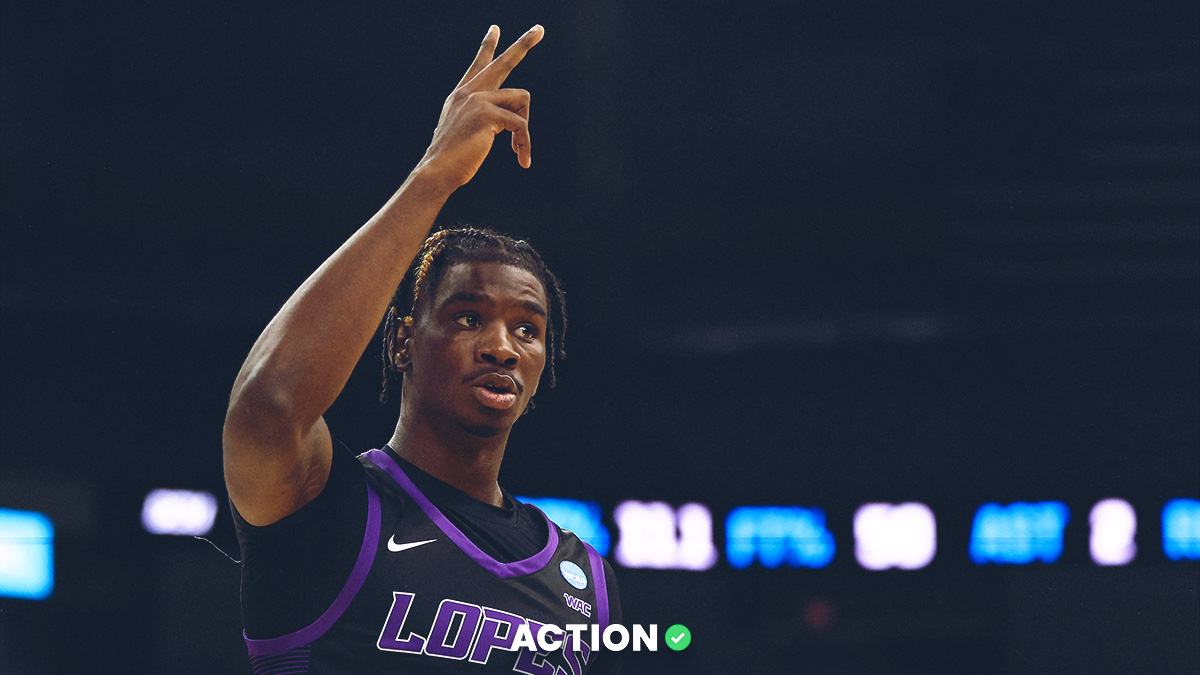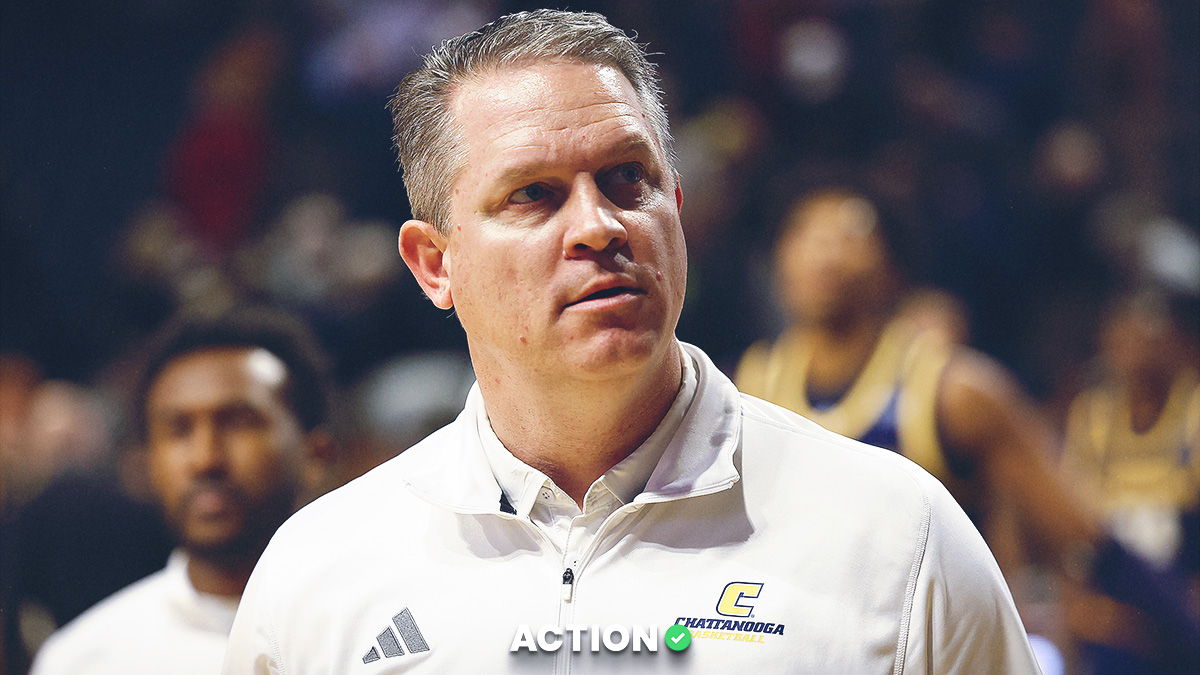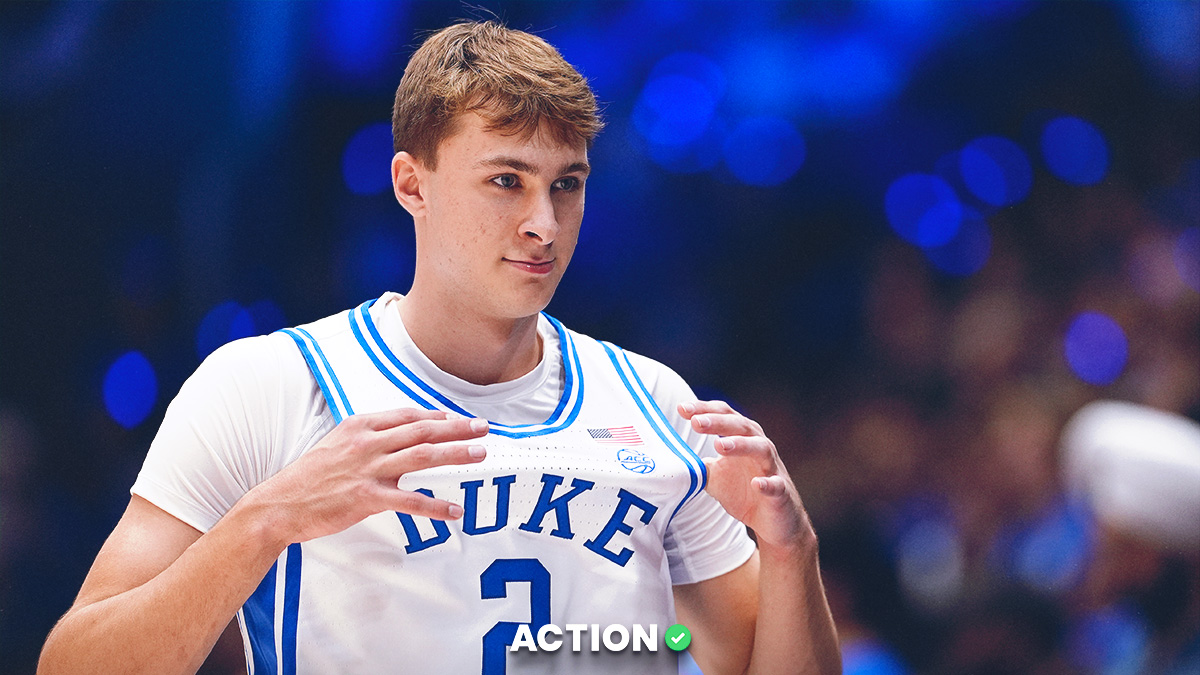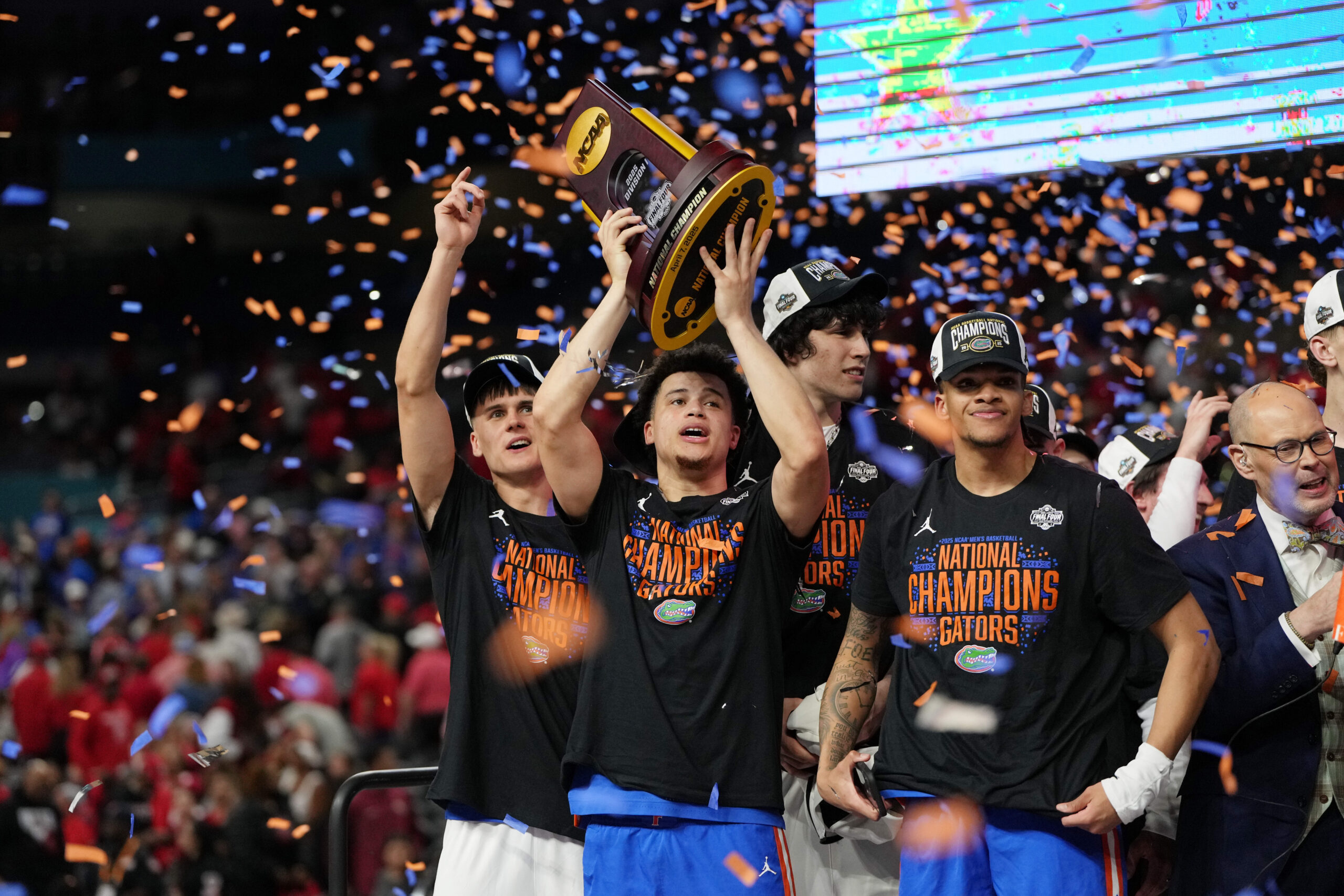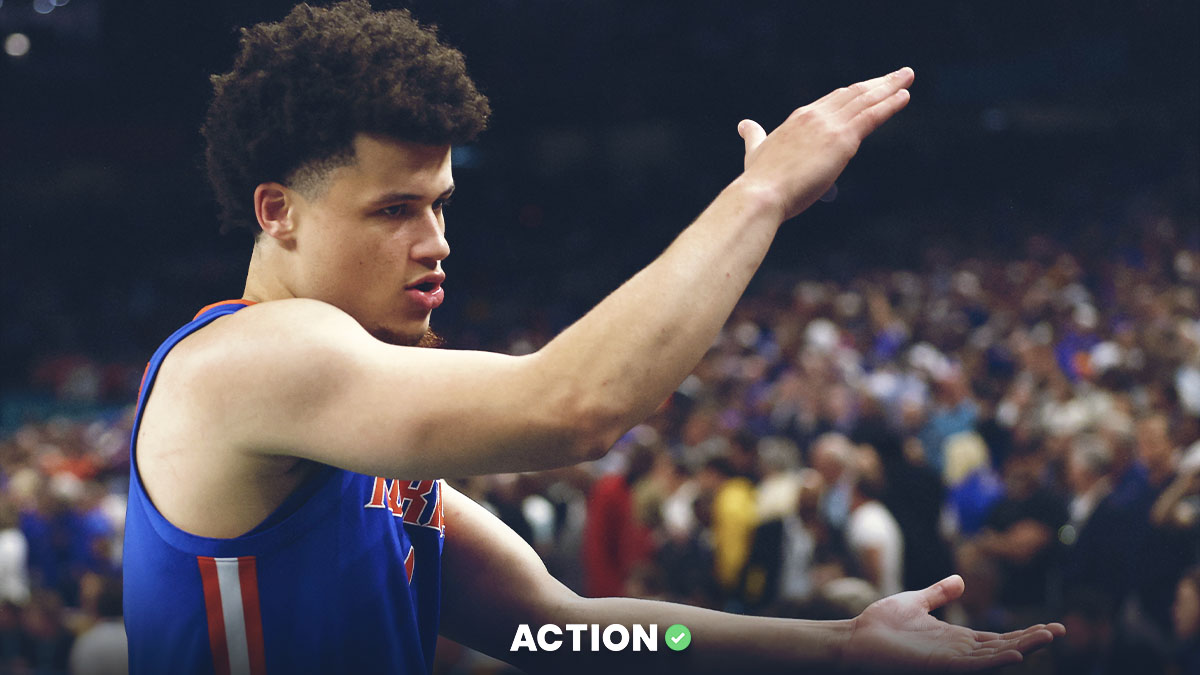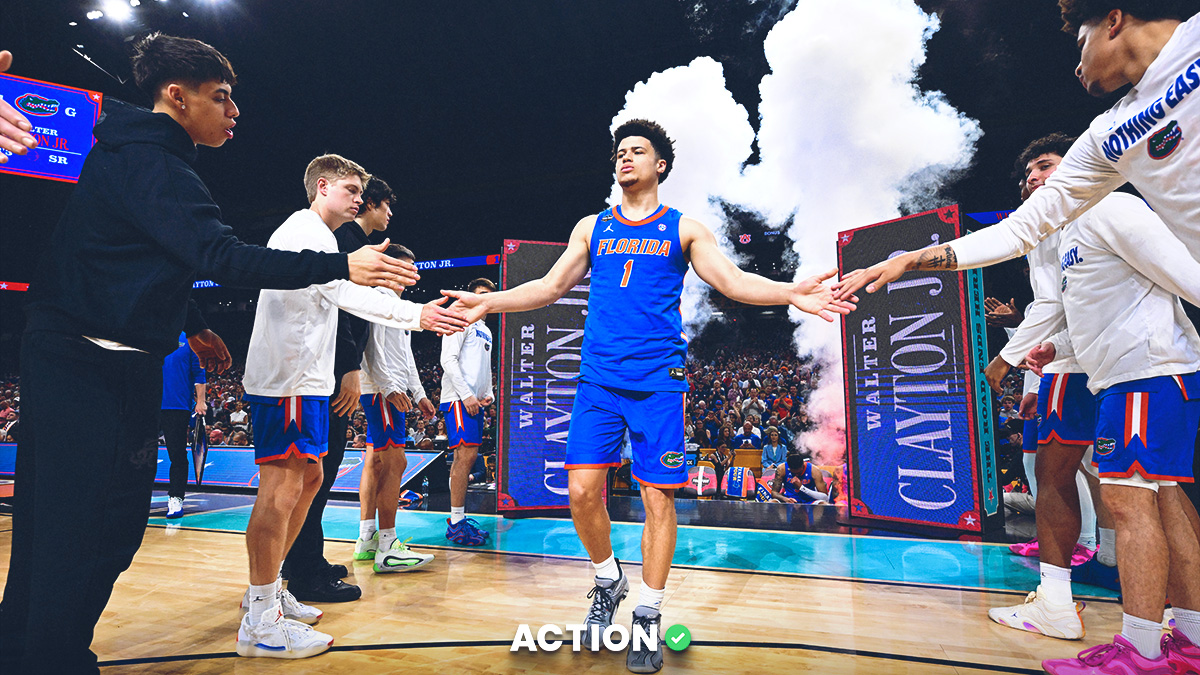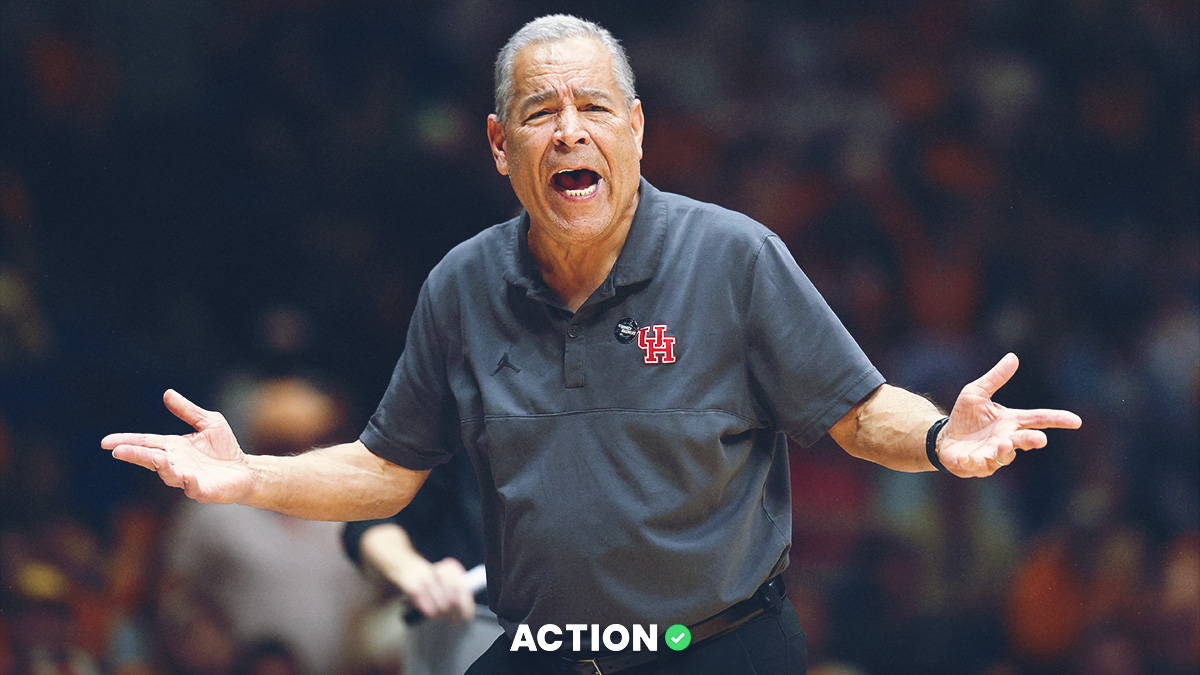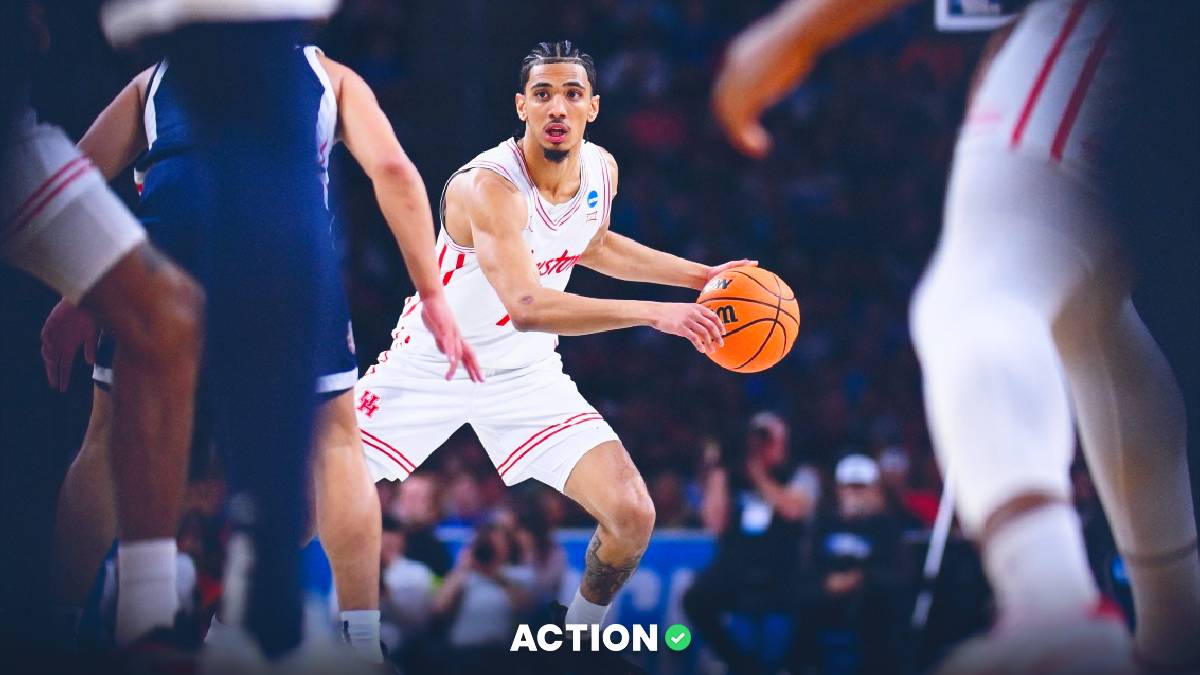I grew up in Vermont, and I grew up on Catamount basketball.
As I followed the league, I became an America East fanatic. As I established myself in the sports writing world, I finally convinced my editors to let me cover the league as an uber-in-depth beat writer.
Needless to say, these conference preview pieces are the most important thing I write all year.
This year, I pulled out all the stops, interviewing five of the nine head coaches to gain invaluable insight into this relatively unknown low-major league.
But maybe you should know about it – the AmEast is moving up in the college basketball world.
The league finished 21st in KenPom’s conference ratings last season, its highest finish since 2013. AmEast squads picked up victories over FAU (Bryant), South Florida (Maine) and Charleston (Vermont).
Eight of the league’s 15 All-Conference players returned for this year, and only one of those seven losses came via the portal — the rest graduated. The America East has the sixth-most returning minutes of any college basketball conference.
Players want to play in this league!
Maybe because it’s fun.
Bryant's realignment and significantly increased pace from Albany, New Hampshire, UMBC and UMass Lowell made the America East the fastest-paced conference in the nation last season (71 possessions per game).
While there’s a fascinating contrast in pace between the up-tempo squads and the plodding styles of Vermont, Maine, NJIT and Binghamton, you should still expect more shootouts like the 114-102 regulation thriller between UMBC and Albany last February.
All that said, here's my deep dive America East Conference preview for the 2024-25 college basketball season.
2024-25 America East Regular Season NCAAB Conference Title Odds
| Team Name | Odds (Via BetMGM) |
| Vermont | -200 |
| UMass Lowell | +325 |
| Bryant | +800 |
| Maine | +2500 |
| UMBC | +3000 |
| Albany | +3000 |
| Binghamton | +3000 |
| New Hampshire | +3000 |
| NJIT | +4000 |
The America East Big Three
Vermont Catamounts
In 1987, Northeastern – led by future NBA All-Star Reggie Lewis – won its fourth-straight Eastern Collegiate Athletic Conference North conference tournament title.
The conference has undergone two name changes since, but the America East Conference Tournament Most Outstanding Player award is still named after Lewis.
John Becker and Vermont will attempt to repeat the Huskies' feat nearly 40 years later.
“We’re excited about the opportunity,” Becker says in an interview with The Action Network. “I think there's more excitement than the weight of expectations."
The Catamounts have won at least a share of the regular-season title in eight consecutive seasons. They capped off a 15-1 season last year, holding off up-start challengers UMass Lowell thrice and Bryant twice.
“Bryant and Lowell have been knocking on the door the past couple of years,” Becker says. “I think that will make for a really interesting and challenging conference season.”
It’ll be nearly impossible to knock off the ‘Cats this year. Four starters return from last year’s dominant squad, including over 75% of minutes. They’re the second-most experienced team in the league (Lowell). Most of the team that rolled through conference play last season returned – how do you beat that?
Becker’s been around Burlington for a long time, but he’s never built a defense this elite. The 2024 Catamounts finished 61st nationally in defensive efficiency, including eighth in scoring defense (62.7 PPG allowed) and 29th in points per possession allowed (.85).
Vermont led the America East in eFG% allowed (45.2%), 2-point shooting allowed (45%), free-throw rate allowed (21.9%) and defensive rebounding rate (19.2%) – it also finished second in block rate (12.9%).
That all starts with Shamir Bogues and Ileri Ayo-Faleye.
Bogues transferred in from Tarleton State last year and instantly became Vermont’s highest-usage two-way player. He’s the prototypical bully-ball point guard. I’ve been watching Vermont games for two decades and have never seen a more devastating point-of-attack defender don the Catamount green.
He’s lengthy (6-foot-4), laterally mobile, versatile enough to defend one through four and shows lightning-quick hands. He recorded two steals per game and led the conference in steal rate (4.1%) last season. He nabbed 13 steals in Vermont’s three-game conference tournament run, earning the Reggie Lewis award for his efforts.
He can do everything. He’s a literal glove. He defended every opponent’s lead guard and passed every test with flying colors.
He overwhelms off-ball shooters (.20 PPP allowed, 99th percentile). He defended 87 ball screens last season (93rd percentile), holding opposing ball-handlers to 21-for-68 (31%) shooting with 16 turnovers – his efforts veering Lowell’s ball screens in the second half of the conference tournament championship game were arguably the most significant reason Vermont won.
Video via Synergy Sports.
Becker often leverages him in a one-man full-court press against the AmEast’s quicker, scarier guards — for example, New Hampshire’s Ahmad Robinson in last year’s conference tournament semifinal game.
Video via Synergy Sports.
While Bogues shuts down defenders at the POA, Ayo-Faleye has evolved into (arguably) Vermont’s most dominant interior defender ever.
Ayo-Faleye is among the most versatile, athletic defenders I’ve seen at the low-major ranks. He’s laterally quick and vertically bouncy. He defends at all three levels. He walls up on the block (.67 post-up PPP allowed, 83rd percentile), holds roll-men at bay (.36 roll-man PPP allowed, 95th percentile) and shuts down opponents in isolation (.36 iso PPP allowed, 96th percentile).
He contests or deters everything at the rim while swatting 1.4 shots per game at a 6.8% rate (89th percentile). Vermont’s rim defense was four percentage points better with Ayo-Faleye on the court last season, and he’s arguably the main reason Vermont led the conference in paint points per game allowed (30).
This play always gets me:
Ileri takes one massive hop step from the right low block around Rafael Pinzon, shows off his insane vertical to swat Earl Timberlake’s mid-range floater, and then hauls down the floor for a reverse finish. The two-way athleticism is staggering.
Ayo-Faleye also performed his best in crunch time — for a team that lacked late-game execution — winning close games with insane defensive efforts.
He had four blocks in Vermont's regular-season title-clinching game against Lowell. He had five in the first head-to-head win, including three obnoxiously good plays at the end of regulation and overtime.
Video via Synergy Sports.
He posted a monster near-game-winning block in a one-point road win over Brown.
Video via Synergy Sports.
The Catamounts matched up with New Hampshire and Conference Player of the Year Clarence Daniels in the second round of the conference tournament. Ileri held Daniels to 14 points on 6-for-18 shooting while dropping 19/8 on the other end, earning KenPom Game MVP honors.
He's the anchor for Vermont's best-ever defense. Vermont's net rating was 16 points better with Ileri on the court than off last season. He's my pick for Conference Defensive Player of the Year — he should've been last year.
With Ileri and Shamir on the court, the 2023-24 Catamounts posted a 92.8 defensive rating behind a 43.1 eFG% allowed. With them off, those numbers dipped to 112.9 and 52.6%. They are among the most impactful defenders in college basketball.
With those two back in the fold, almost nothing else matters. With Bogues stopping everything on the perimeter and Ayo-Faleye stopping everything on the interior, the defense will remain top-tier.
“Last year’s team was elite defensively, and I believe this year’s team will be even better,” Becker says. “We have five or six guards with great size and defensive instincts.”
Vermont’s guard corps is lengthy. Bogues, TJ Hurley, and TJ Long all stand around 6-foot-5. Second-unit point guard Jace Roquemore stands 6-foot-5, and they’re moving the 6-foot-5 Sam Alamutu into the backcourt after playing as an undersized four-man last year.
In fact, Vermont has never had this much depth. The Cats bench played 37% of total minutes last year, the 57th-highest mark nationally and the highest in the Becker era. That's been a massive advantage since the conference moved from a Wednesday-Saturday schedule to a Thursday-Saturday one — the Cats are generally fresher on 48-hour turnarounds.
I'm consistently impressed with Roquemore's minutes off the bench. He's such a calming two-way presence for the second unit. He takes high-efficiency shots, makes good passing decisions, defends without fouling, rebounds, et cetera. He's a spectacular glue guy.
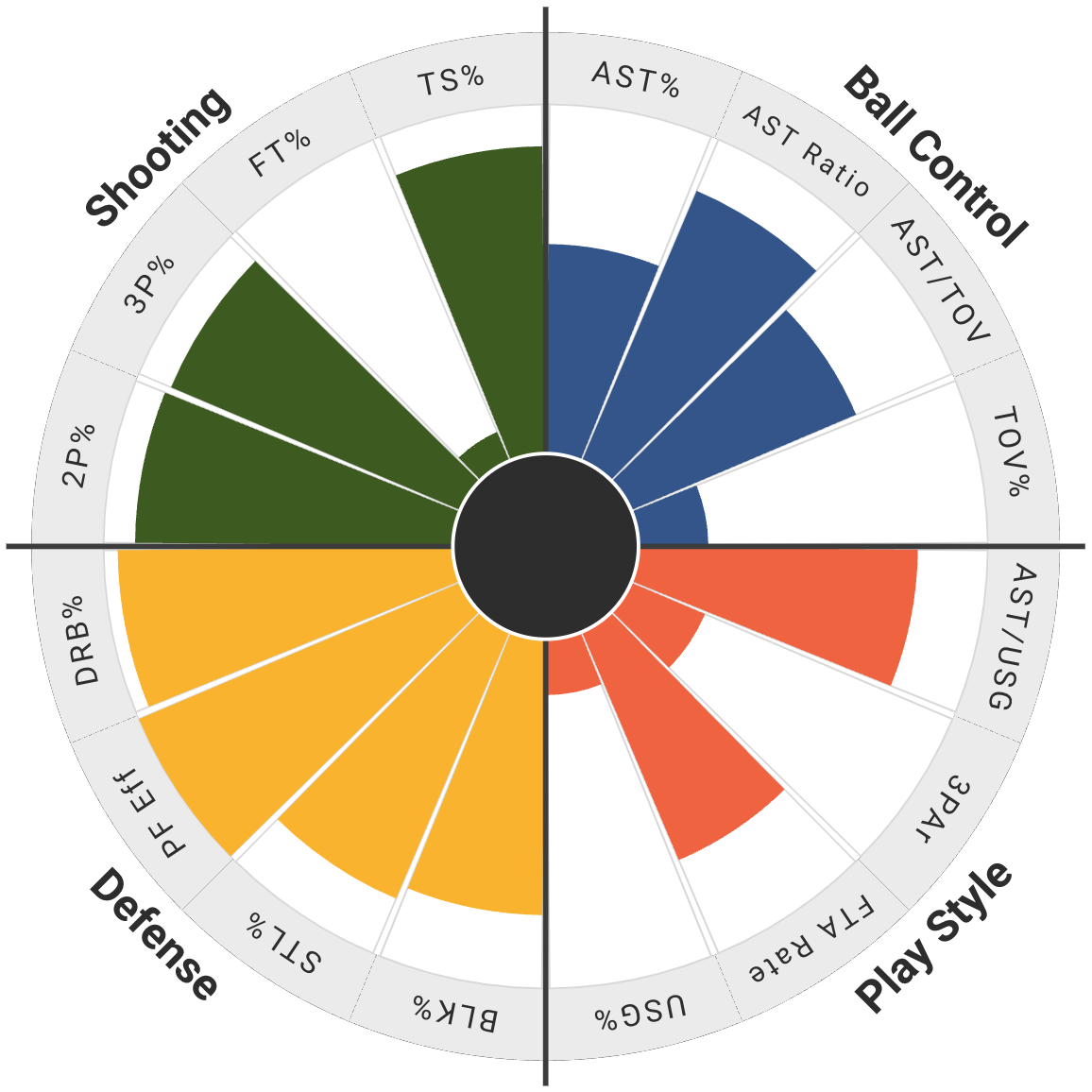
Alamutu is raw but brings a uniquely high motor — a true spark plug off the bench. He offers Vermont different looks as a versatile middle-of-the-floor two-way playmaker. He gives Becker some extra lineup flexibility, and he's got a high ceiling if he refines his skillset.
“Alamutu did an incredible job as an undersized forward, but he'll play as a guard this year,” Becker says. “He and Jace will likely be the first two guys off the bench. Long has made strides defensively after being in our program for a year, and I think Hurley is also a tremendous defender.”
For what it's worth, keep an eye on Hurley as the starting two guard. He's always been a good shooter and floor spacer, but I'm hearing rumors of a vastly more well-rounded offensive skill set.
Vermont runs a fairly conservative man-to-man defense. The Catamounts rarely press and don’t care to force turnovers, preferring to focus on cleaning the glass. But with Ayo-Faleye anchoring the interior, Becker can leverage his lengthy backcourt to contest everything – over 70% of opposing catch-and-shoot jumpers were guarded last year, the third-highest rate nationally.
Additionally, Becker’s dynamite transition denial defense shouldn’t miss a beat, which is uber-important as the rest of the league plays faster.
"We have our transition defensive principles that the guys do a good job with," Becker says. "We're not a good offensive rebounding team, and with everyone playing five out, you have a lot of guys outside the three-point line, already halfway back in transition. If you're not going to be a good offensive rebounding team, you better be a good transition defensive team, and that's what we've been."
That’s a good "transition" point into the offense. The 2024 Catamounts posted their lowest offensive efficiency mark since 2015.
What happened?
Becker runs a down-tempo, five-out spread offense predicated on ball movement and spot-up shooting. Hurley (career 37% from 3) and Long (career 36% from 3) are terrific shooters at the two and three guard spots, while Nick Fiorillo is a fantastic stretch four (33% from 3 last year) who's good in the pick-and-pop game.
But Bogues (career 26% from 3) and Ileri (career 30% from 3 on low volume) are poor shooters. They're too important defensively to take off the court, which messed with Vermont’s usually elite spacing last year and created far too many prolonged draughts of stale offense.
In the past, Vermont had stellar back-to-the-basket big men who could score on the block or off the roll. So, the Catamounts would leverage them during shooting draughts, dragging defenses toward the interior and re-opening the perimeter for the ever-elite shooting corps.
Last season, the only answer was passing to bully-ball Bogues and getting out of the way. He’s a devastating off-the-bounce downhill rim runner and strong enough to finish through almost any contact. He scored 8.4 paint points per game last year on over 50% shooting.
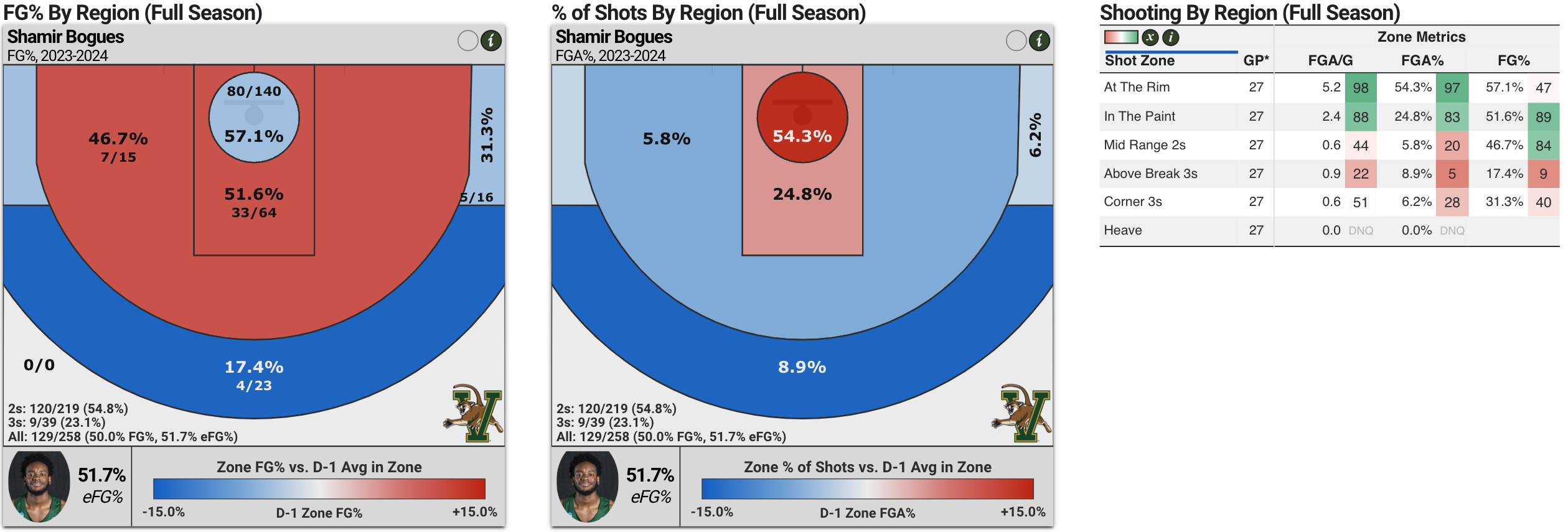
"It was a struggle offensively because teams didn't want to guard Ileri, Sammy and Shamir," Becker says. "We turned Shamir into a post-up guard like we did with Robin Duncan the year before, but we couldn't throw it big on big. We had no real back-to-the-basket guy, and I don't think Ileri will turn into that this year."
While Ileri is surprisingly efficient as a post bucket (1.03 PPP, 84th percentile), his offensive game remains relatively unrefined. He’s likely to remain a low-volume offensive contributor.
I see two answers to Vermont’s offensive conundrum.
First, Bogues and Ayo-Faleye simply improve their shooting.
Bogues should refine his offensive game with another year in the system. For example, Ayo-Faleye made monster strides as a floor-spacer (18-for-59 for 3, 31%) in the five-out last year, and he often leveraged the threat of a spot-up shot to pull slower big men toward the perimeter, drive past them and score with easy positioning.
Video via Synergy Sports.
I've heard from my sources inside the program that Ileri's 3-point shot looks much "cleaner" this year.
"Ileri, Sammy and Shamir have worked hard on their shooting in the offseason, and they've improved," Becker says. "We'll see how it pans out in games, but they took offense to how they were guarded in games last year."
The second, more intriguing option is giving more shots to Howard transfer Shy Odom.
Odom spent most of last season hurt, but he earned MEAC ROY honors the season before behind 11 PPG on 56% interior shooting. He’s a Howard legend for his 2023 postseason run, where he averaged 13/7/2 on 65% shooting between a three-game conference tournament run – where he earned Tournament MVP honors – and an NCAA Tournament first-round game against Kansas — which the Bison covered.
Odom could be the back-to-the-basket threat that fixes Vermont’s interior scoring deficiencies. He’s a crafty, creative interior scorer who can leverage his strength into double-digit paint points per game on high efficiency with high usage. He’s solid off the roll, as a cutter, or in the post, three primary ways the Catamounts try to create interior offense. He also loves getting to the line and cleaning the boards.
“He has a body type similar to Anthony Lamb and Isaiah Powell, undersized at 6-foot-5 or 6-foot-6 but strong in his lower half,” Becker says. "He plays bigger than his size, and we're hoping he's someone we can play through the post."
Also, don’t overlook his interior passing ability. He posted a whopping 14% assist rate in his rookie year, averaging almost two assists per game and peaking with a six-assist performance against South Carolina State. He could be devastating as a short-roll passer in the Catamount system, something Fiorillo did well last year and Duncan the year before.
"His passing stands out to me — he's an unselfish player with an incredible feel," Becker says. "Shy fits the mold as a hub for the offense. He understands how to keep the ball moving with pace."
I will mention that monitoring Vermont's pace this season is a must. Through the Summer and Fall, Becker has emphasized that he wants his team to play a little more up-tempo than in the past, explicitly trying to get Bogues to the rim in transition and Ileri to the basket on more rim-running sets.
"We've had discussions about playing faster, and I think that's something we're going to do this year," Becker says. "There are advantages to playing up-tempo."
Then again, it's hard to envision Vermont making monster adjustments in pace of play. The Cats haven't ranked inside the top 250 nationally in adjusted tempo since 2016.
"I've always struggled with it because I hate turning the ball over, and we've consistently been one of the best assist-to-turnover teams," Becker says. "Can we play fast and smart? Can we take care of the ball and maintain good shot selection?"
I guess it remains to be seen…
Catamount Betting Thoughts
My only concern about Vermont is frontcourt depth.
Fiorillo (plantar fasciitis) and Odom (ankle) have been dealing with nagging injuries all Summer. Further injuries would force Seth Joba and Noah Barnett, two unproven commodities, into significant minutes.
Additionally, Fiorillo’s defense worries me. He’s slow-footed laterally, so he was consistently burned in isolation (1.43 PPP allowed, first percentile) and in ball screens (1.29 roll-man PPP allowed, 13th percentile). During last year’s conference tournament, Albany consistently targeted him on drag screens, while UMass Lowell ripped him apart in ball screens — you can score on him if you move him around.
Video via Synergy Sports.
Then again, his predecessor, Matt Veretto, wasn’t a much more effective defender (1.07 iso PPP allowed, 17th percentile; 1.26 roll-man PPP allowed, 15th percentile), and that wasn’t an issue. Becker describes Fiorillo as a good “positional defender,” which shows up in his post-up defensive metrics (.79 PPP allowed, 64th percentile).
Otherwise, I’m pretty sold on Vermont.
The defense already has such a high floor with the Ileri-Shamir bookends, and I expect the team to improve with another year in Becker’s system. With all that length and depth, the perimeter defense will be elite.
I wouldn’t be surprised if Vermont snuck into the top-50 nationally in defensive efficiency. The key would be shoring up a sometimes-sketchy ball-screen defense, which may fall on the shoulders of Fiorillo and the somewhat limited frontcourt depth.
Meanwhile, the offense can only improve. Bogues and Ayo-Faleye should improve as shooters and floor spacers, and Becker has plenty of other options — a big interior scoring season from Odom could end all scoring draughts in Burlington.
"The addition of Odom and the growth of Joba and Barnett should give us more balance," Becker says. "We can throw it inside on one-on-one matchups and create offense that way, along with Jace and Shamir walking into the mid-post and being playmakers. We'll have a more inside-out offense this year, where last year we were one-dimensional with spot-up shooting."
The America East is scary this year. I believe both UMass Lowell and Bryant will improve. I also think Albany, Maine and UMBC are dangerous sleepers.
I also think the Catamounts will be improved, which is crazy to say after a 15-1 season. All the pieces are back, and everyone seems to have some untapped upside.
I’m most interested to see if this could be the team that finally gets back to the NCAA Tournament’s second round. Vermont hasn’t had this much athleticism and versatility in a long time. We’ll learn about those prospects early, as the Cats open their season with a southeastern road trip to UAB and Auburn.
Given the league's competitiveness, I think the price is too steep (-200). But, ultimately, Kings stay Kings until proven otherwise.
UMass Lowell River Hawks
The River Hawks will again play through their frontcourt.
The three returning starters — Max Brooks, Cam Morris and Quinton Mincey — are arguably the conference's three most dynamic offensive forwards.
Pat Duquette runs a variation of the flex-motion offense, but one that prioritizes on-ball dribble penetration, slashing and cutting. The big men will cut, roll, post and ultimately live at the rim. The River Hawks score in the paint (40 paint PPG), grab offensive rebounds (31% rate) and draw fouls (24 FTA per game) at unmatched AmEast rates, creating the league’s top offense last year by efficiency.
All three big men are elite at all three things.
Brooks is the face of the River Hawks as a two-way interior bulldozer. He’s well known as the league’s best interior shot eraser, as he blocks two shots a game, stands tall in post-up sets and allows Lowell to switch one through four on the outside while he plays as a drop-coverage defender.
He’s also a vacuum on the glass.
But he’s arguably a more impactful offensive player. He scored 12 points per game last year on 61% shooting, including 10 in the paint at over 80% shooting. He’s among the league’s best post-up threats (1.09 PPP, 90th percentile), but his value comes from his motor and effort.
As written in Blue Ribbon: “The River Hawks rarely have to run sets for him because Brooks can create off of screens he sets or get second-chance opportunities.” He averages over three second-chance points per game on over two offensive rebounds per game. The River Hawks shot five percentage points better at the rim with him on the floor last season.
On offense, Morris and Mincey’s offensive value comes as wing slashers.
Morris is more of a pure rim-runner as a cutter or roller. He obliterated Vermont in ball-screen pockets during the first half of last year’s conference tournament championship game, finishing the game with 17 points, shooting 5-for-7 from the interior and 7-for-10 from the line.
Video via Synergy Sports.
He also shoots 39% from 3 — albeit on low volume — and grabs nearly six boards per game, including nearly three offensive rebounds.
Mincey – the reigning AmEast Sixth Man of the Year – is more of a spot-up shooter and slasher, especially when driving to his left. He shoots 34% from 3 on decently high volume and can cook in the pick-and-pop game.
Video via Synergy Sports.
He scored 14 points per game last year while drawing nearly 10 free-throw attempts per night (the most in the conference) and grabbing seven boards per game.
Those three will run the show for the River Hawks, and I also don’t mind throwing Mekhi Gray in the frontcourt mix.
The NJIT transfer is a solid, versatile wing defender despite his undersized frame (6-foot-4, 190 pounds) – he averaged nearly two stocks per game last season. His offensive game is limited and inefficient, but he’s no stranger to paint points. For what it's worth, NJIT's net rating was 20 points higher with him on the court than off last season.
He also gives the River Hawks another excellent rebounder – the team isn’t short on two-way glass smashers.
It’s not all rosy in the frontcourt. When Abdoul Karim Coulibaly ran the interior with Brooks, the River Hawks had a dominant rim-oriented offense and defense.
They can still play drop-coverage with Brooks; he will always hold his own down low. But the scheme inherently forces a lot of isolation and rim-funneling sets, two areas where Mincey and Morris are vulnerable.
Morris can hold his own in isolation, but he’s a below-average post-up defender (.92 PPP allowed, 41st percentile), which can hurt when opposing bigs force him to defend back-to-the-basket offense.
Mincey is a sieve. He was the sixth-worst post-up defender in the conference last year (1.26 PPP allowed), and the five guys behind him were smaller guards. He was one of only two AmEast players forced to defend over 30 isolation sets last year, and he allowed .88 PPP (38th percentile).
With him on the floor last season, Lowell's defensive rating jumped 10 points (104.8 vs 94.8).
Imagine Bryant or Albany’s iso-hunting, rim-running offenses against Lowell’s iso-forcing defense. If a versatile scoring wing or forward like Earl Timberlake or Amar’e Marshall manages a switch onto Morris or Mincey, it’s barbecue chicken.
That’s a problem. It’s the main reason Lowell sank toward the league average in defensive efficiency (101.7, fourth) and toward the league’s bottom in paint points per game allowed (37, seventh) last year. The River Hawks allowed the highest rate of isolation possessions in the league and ranked second-to-last in isolation PPP allowed (.84).
The drop-coverage scheme was still largely effective in running guys off the 3-point line last year — dropping your interior defender allows perimeter defenders to overplay ball handlers and wing shooters. But Duquette tried running more on the level, switching ball-screen coverage down the stretch, which hurt their perimeter shooting coverage.
That’s a problem against Vermont, which can attack Lowell over the top or target the Mincey-Morris duo in ball screens, depending on which defensive route Duquette opts for.
The backcourt rotations are fuzzy. Ayinde Hikim was a three-year, high-usage guard who did everything for the River Hawk backcourt, including pushing the pace, setting the table for the scoring forwards and swarming as a POA defender.
His de-facto replacement, Quincy Clark, is a solid facilitator (three assists per game, 25% assist rate) with quick hands (1.2 steals per game, 3% steal rate). Still, he grades out much worse as a ball-screen defender (.89 PPP allowed, 28th percentile) and is ineffective as a scorer (38% from the field, 25% from 3).
He doesn't turn the ball over as much as Hikim did, but he wasn’t a stud in that department either (2.2 per game, 20% rate).
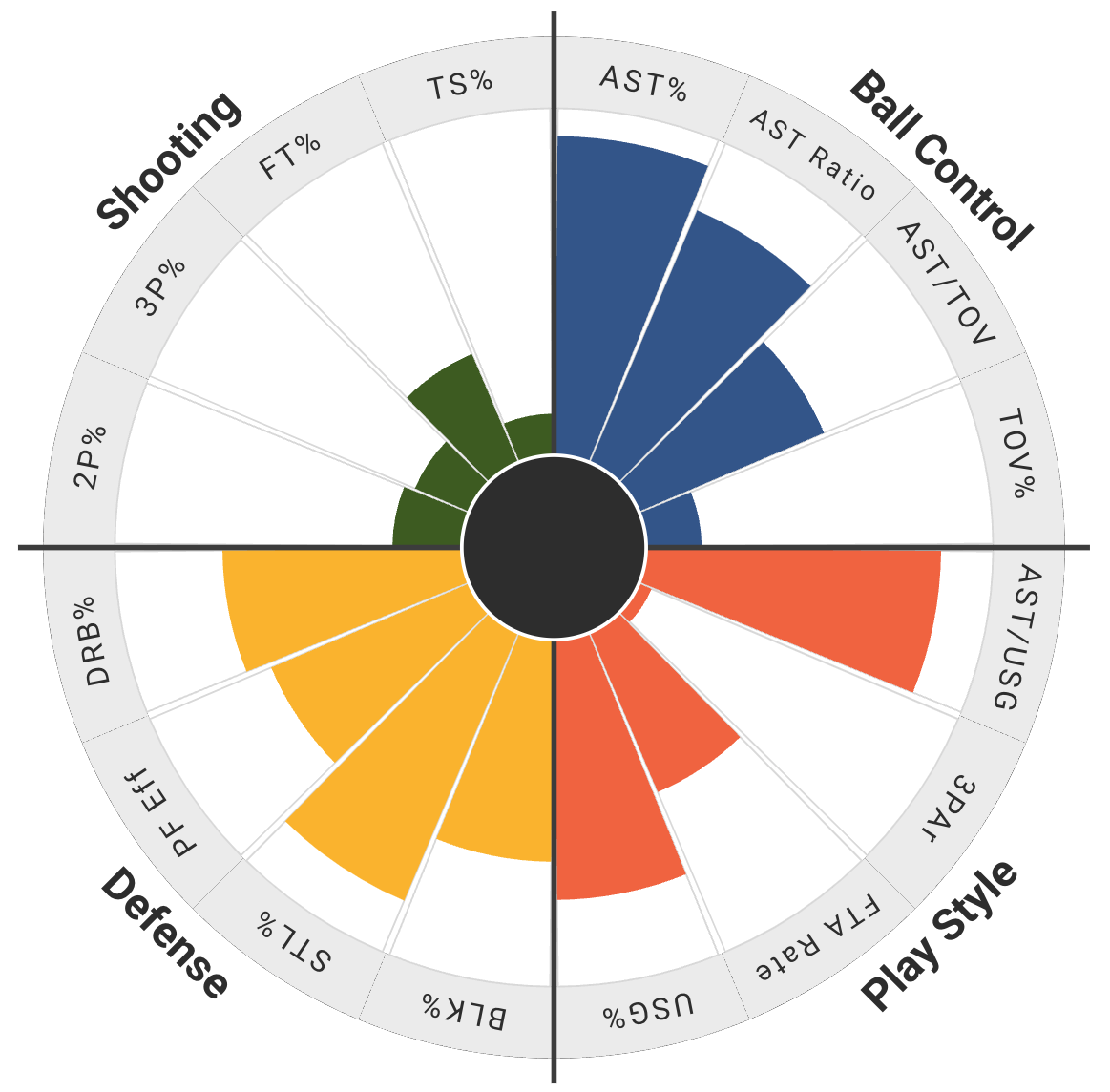
DePaul transfer Caleb Murphy is a far more enticing option. The former four-star recruit averaged 11/3/3 for South Florida in the AAC, but he never got much run at DePaul.
At his best, he’s an explosive, athletic combo guard who can finish at the rim, dish out four to five assists a night and defend at a high level.
Sadly, I’ve heard rumors that he may not be available until January. But he’ll be around during conference play if that gets sorted out, which is all that matters.
Perhaps that'll give freshman guard Martin Somerville a chance to earn significant minutes. The 6-foot-3 Southern California Academy point guard prospect is known as a smooth southpaw shooter, but expectations within the program are much higher.
"I haven't had a kid, a freshman, who plays with that much confidence and poise," Duquette told Blue Ribbon. "He's going to have an impact. He doesn't play like a freshman."
And the River Hawks will always have Yuri Covington as a steady 3-and-D force at the two. He does all the little things so well, like can 34% of his long balls on high volume and snatch 1.4 steals per game while swallowing up guards in ball screens (.65 PPP allowed, 75th percentile) or wings in spot-up situations (.61 PPP allowed, 95th percentile).
River Hawk Betting Thoughts
I fear I’ve been too hard on the River Hawks — I hope my Catamount bias isn't showing.
The frontcourt production gives Lowell an incredibly high floor. They should be the best offense in the league again, and they’ll score consistently on a night-to-night basis because they’ll consistently earn second-chance points and get to the line – they’ll never go through scoring draughts like Vermont or Bryant.
They’re also the most experienced team in the conference. This is year five in the program for Brooks, year four for Mincey, year three for Covington and year three for Morris. Nine of the top 10 rotation guys are either seniors or super seniors. This is arguably the most talented River Hawk team of all time.
Lowell dominated Northeastern in a secret scrimmage last week, winning 84-57 behind 18 points from Mincey and 16/3 from Clark. The River Hawks aren’t going anywhere, and Duquette will keep knocking on Becker’s door.
Still, I can’t shake the feeling that last year was their best chance to break through. Vermont is stronger and more experienced this season, while the River Hawks are trying to replace a monster backcourt piece “in the aggregate,” as Duquette told Blue Ribbon.
They’ll slash their way to points against the league's top, but I worry about earning consistent stops.
I think for the River Hawks to hit their ceiling, Murphy or Somerville need to establish themselves as a legitimate explosive point guard option. Pairing that with a steady two-guard and the league's best offensive frontcourt would send shivers down the Catamount spines.
We’ll see. It might be another season of being this close without getting over the hump.
I’m excited about Lowell’s West Coast road trip during the second week of November. It'll play Gonzaga on Nov. 15 and Washington on Nov. 17, which will be a pair of offensive-minded higher-scoring games between up-tempo frontcourt-heavy squads.
We’ll learn a lot about the Brooks-Morris-Mincey trio against Graham Ike and Great Osobor.
Bryant Bulldogs
The single most impressive thing in the America East last season was how Bryant transformed its defense.
First-year head coach Phil Martelli Jr. ditched his predecessor’s matchup zone defense in favor of a more aggressive ball-screen denial that forced iso-ball rim-running. The Bulldogs then leveraged their unmatched wing athleticism to deny the rim viciously.
There are some Houston ball-screen blitzes, Iowa State rim denial and Virginia pack-line elements baked in, but the result is an attacking defense that leverages athleticism in scrambling and recovery to swarm the paint and swat shots.
The 2024 Bulldogs ranked second nationally in blocks per game (6.5) and first in at-the-rim points per shot allowed (.95). They led the AmEast in block rate by a mile (15%).
It's nearly impossible to score against them. They take away the perimeter (top 100 nationally in 3-point rate allowed) because they want you to attack the rim, but you can't score down there against their athletic wings.
They funnel ball-screen creators (.67 PPP allowed, 92nd percentile), cutters (.96 PPP allowed, 98th percentile) and spot-up shooters (.86 PPP allowed, 88th percentile) toward the rim, only to obliterate any hopes of putting the ball in the basket.
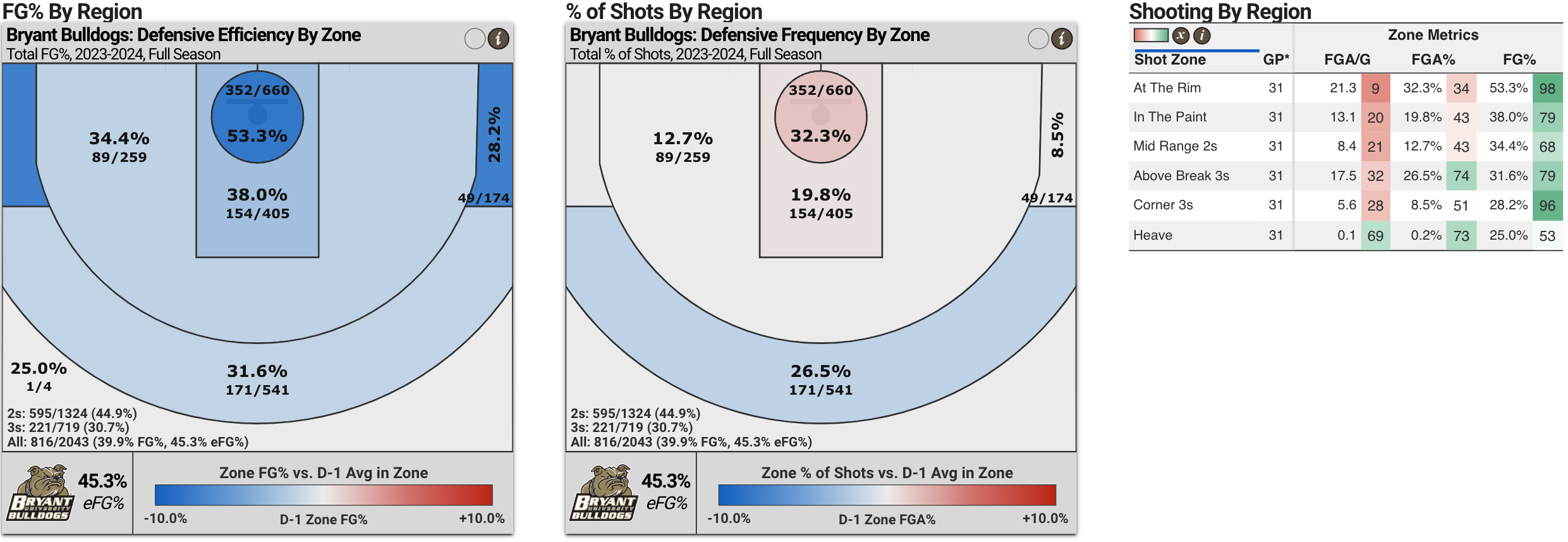
“It isn't schematic as much as it is emphasis,” Coach Martelli tells The Action Network in an interview. “We work on verticals. We don't really talk about shot-blocking. But when you have guys with IQ, anticipation, length and athleticism, that's what you get."
The defense fuels Bryant’s hyper-up-tempo, transition-on-steroids offense.
Nobody in the country averaged more possessions per game last year (74). Only Western Kentucky and Iowa scored more transition points per game (20.7).
Off a block, Bryant is going to run. On a miss, Bryant is going to grab and go. On a make, the Bulldogs are already pushing the ball down the court before even inbounding the basketball.
“It all starts with defense – we want to get stops and get into transition,” Martelli says. “With our athleticism and our ability to play in the full court, that's always going to be key for us."
The half-court scheme is primarily built around identifying one-on-one matchups. The Bulldogs leverage hand-off sets to attack in isolation.
Video via Synergy Sports.
They also love cutting off other players' attacks and taking advantage of help defense.
Video via Synergy Sports.
Ultimately, Martelli gives his guys a lot of freedom to attack and attack quickly. The players generally have a talent and athletic advantage, so they leverage that. The scheme ultimately results in a ton of shooting and scoring – albeit sometimes inefficiently (more on that later) – often at the rim.
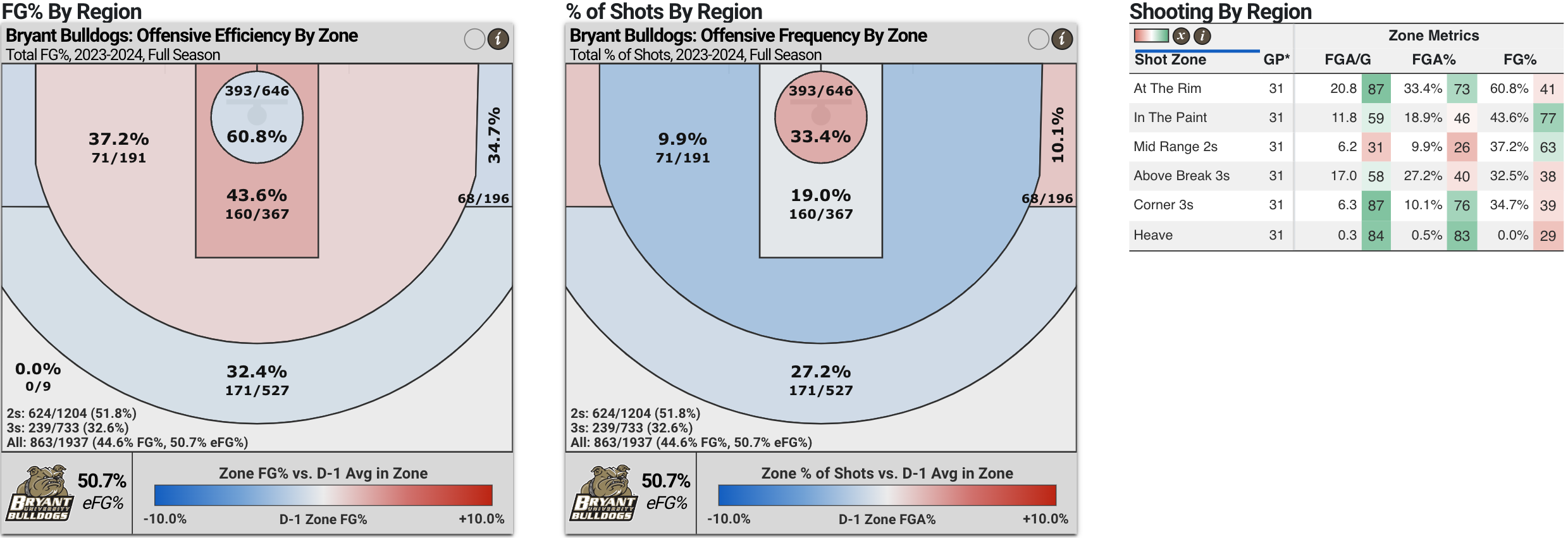
The scheme will remain the same, but the players executing it will be much different.
The roster is experiencing a lot of turnover. Only 32% of last year’s minutes return. The Bulldogs lost 167 of their 273 made 3s from last season, most of that shooting production from the backcourt.
They also lost two All-Conference players, Sherif Gross-Bullock and Daniel Rivera.
But there's no shortage of talent. Bryant has the most talented and athletic roster in the America East year in and year out.
Everything starts and ends with Timberlake, my pick to win Conference Player of the Year.
Timberlake is one of those unique point-forward types – he reminds me of a low-major Oso Ighodaro or Osobor. He’s an elite interior scorer who is comfortable scoring in post-up sets (1.11 PPP, 92nd percentile) or off cuts (1.59 PPP, 96th percentile). He’s an insane two-way rebounder, averaging nine per game last season.
But he’s even more comfortable running the offense with the ball in his hands, averaging four assists per game on a 21% rate. He initiated more of Bryant’s offense as the season progressed last year, yet consistently improved on his turnover rate.
He peaked with a 15/11/10 triple-double against Drexel in December. In eight February games, he averaged 18/9/4 on 63% shooting.
And he did it all while acting as one of the critical cogs in Bryant’s paint-swarming defensive scheme, blocking 1.4 shots per game while seldom fouling.
Say hello to the best player in the America East:
“Earl is a coach’s dream,” Martelli says. “He approaches work like a professional. I ask a lot of him — bring the ball up, score it, guard the best guy on defense, lead your team — but I know he can handle it because he's a warrior."
The other two returnees, Pinzon and Connor Withers, also ooze talent.
Withers is among my favorite AmEast guys, dating back to his UMass Lowell days running alongside Obadiah Noel. He’s a wing/forward tweener who looks most comfortable as a spot-up shooter (36% from 3 last year). But he's surprisingly effective as a ball-mover (1.8 assists per game) and – like every other player on the team – shot-blocker (1.5 per game).
"I've been on Connor about shooting," Martelli says. "Any time he gets an open shot, I want him to shoot the ball. Sometimes he's a catch-to-pass-it-first guy, and I want to blend his programming of a playmaker and shoot-first guy."
Pinzon is a Big East transfer who thrived with a step-down in competition, averaging 13 points per game last year as the Bulldogs’ third-leading scorer. He’s a guard-wing type and is most comfortable playing two-way ball on the perimeter. He averaged 26 points on 60%/52%/70% splits over his final four games last year, dropping 35 on Maine and 24 on Lowell in two conference tournament games.
"Rafael is going to be a key guy for us," Martelli says. "He was a monster down the stretch. He's not afraid of any moment — he walks into every game thinking he's the baddest dude out there."
Those returning three give Bryant a high floor. How the rotation shakes out around them will decide the ceiling.
The biggest question is the backcourt rotation. As mentioned, the Bulldogs lost a significant amount of backcourt production. Specifically, they lost four impactful shooting guards: Gross-Bullock (18 PPG, 35 3P%), Tyler Brelsford (7 PPG, 33 3P%), Doug Edert (5 PPG, 37 3P%) and Miles Latimer (3 PPG, 37 3P%).
The three transfers are intriguing but largely unproven.
In my opinion, Marist transfer Kam Farris is the safest bet, given his sharpshooting ability.
"We knew Kam was a very good shooter, and that was obviously something we needed to get," Martelli says. "He's been a 40% shooter with range for his whole career, but he's a much better all-around basketball player than I realized."
Canisius transfer Devean Williams will likely be the most “impactful” of the bunch, good or bad, given there’s a shot he starts at point guard. He started the final 10 games for the Golden Griffins last year, averaging 14/4 with nearly two steals over the final seven.
But he also turned the ball over a ton and shot under 40% from the field. That said, he’s a plus defender in the backcourt and won’t be asked to do much on offense with Timberlake running the show.
"He doesn't make loud plays," Martelli says of Williams. "He's just the same guy every day and consistently makes good plays."
Miami transfer Jakai Robinson is the wildcard. He barely played in Coral Gables but is a 6-foot-5 dynamite athlete with high-level defensive skills.
"Jakai is a menacing on-ball defender," Martelli says. "His offensive game is still coming along, but if he embraces that Junkyard Dog mentality where he's flying around, getting offensive rebounds, bullying guys on the defensive end, that's when he has his best days."
However, with a relative lack of depth in the backcourt and the loss of a ball-dominant scoring guard in Gross-Bullock, Martelli has said he hopes to play more through his “uniquely skilled” frontcourt.
“Barry [Evans], Connor and Earl have been our top assist guys through the summer and fall," Martelli says. "It bodes well that we have a bunch of different guys who can make plays. We can play two of those guys together with a couple of smaller guards."
Evans didn’t play much at St. Bonaventure. Still, he was wildly efficient in limited minutes, shooting nearly 70% from inside the arc and 32% from beyond the arc while adding a 13% assist rate, a whopping 26% defensive rebounding rate and an 8% Hakeem rate (steal + block rate).
He could be a real frontcourt threat if he can translate those per-play stats to higher usage.

"He's one of the best athletes I've ever coached," Martelli says of Evans. "He's just so long and athletic and rangy."
I’m very interested in Kvonn Cramer. Similar to Evans, Kramer posted wild per-minute stats at Hofstra. He’s a high-motor two-way center who can finish inside on offense and swat shots on defense. He would've be the starting center last year before a pre-season ACL tear.
"Kvonn has always been a dynamic athlete, and he's had some of the worst injury luck of anybody I've been around," Martelli says. "But he's worked his way back. Some of his touch and stuff wasn't quite there early, but he's gotten that back pretty quickly."
The other guy in the frontcourt rotation is Keyshawn Mitchell, who put together some strong performances toward the end of last season, recording six blocks and 13 rebounds across the season’s final three games.
"Keyshawn came on strong at the end of the year," Martelli says. "He wasn't ready early in the year but kept working and was very good in the last couple of games."
"I'm confident that whatever we've lost rim protection wise and in the frontcourt, we can make up for with those returning guys and some of the newcomers."
Bulldog Betting Thoughts
Martelli doesn’t know precisely how his rotations will shake out – or he just won’t tell me. But we’re both aware of his tremendous lineup flexibility.
“What’s exciting is the versatility we have,” he says. “We can go bigger or smaller, and we have guys who can play multiple positions. We’re uniquely skilled.”
“Versatile” and “uniquely skilled” are good ways to describe this era of Bryant basketball. The program will always emphasize two-way freedom, positionless basketball, constant aggression and high energy behind freak athletes.
The formula for the Bulldogs is clear: They must continue emphasizing athleticism and rim protection on defense while becoming vastly more efficient on offense.
The Bulldogs just didn’t create great shots last year. They ranked eighth among AmEast teams in rim-and-3 rate, sixth in Open 3 Rate and seventh in 3-point shooting (30%). They love to create in transition because they dominate on the open floor (1.13 PPP, 84th percentile).
However, they will still spend most of the time in the half-court, where the offense managed only .88 PPP (36th percentile) overall and .85 PPP on spot-up opportunities (10th percentile) last season.
Losing Gross-Bullock’s monster usage and scoring ability looks poor on paper, but I think there’s some addition-by-subtraction to be factored in. For how incredible he was, he was a turnover and foul machine, and he wasn’t overly efficient at putting the ball in the basket (42% from the field).
By EvanMiya’s BPR, he was only Bryant’s fourth most valuable player last year (+.49) and was a slightly minus offensive player.
One thing is sure: Martelli is a monster coaching upgrade over Jared Grasso. With a fresh slate and an entire offseason to instill his culture, the sky is the limit.
There’s an enormous elephant in the room – Bryant is 0-7 against Vermont and UMass Lowell since joining the America East in 2023. The Bulldogs are good, but it means nothing if they can’t beat the top guys.
"It's not the hidden elephant in the room; we all know it, and we talk about it," Martelli says. "We have to be a little more disciplined. In those tight games, we just didn't have enough discipline to make enough plays to get over the hump."
While it seems like an oversimplification, I think the key to Bryant beating those top teams is if the transfers hit. Can Farris provide enough shooting? Can Williams and Robinson step up as backcourt compliments, especially in this unique system? Can Evans and Kramer prove themselves as high-usage, two-way frontcourt pieces?
Also, Bryant’s transition-reliant offense has flailed in the face of Becker’s dynamite transition-denial defense. If the ‘Dogs want to beat the Cats, Martelli must scheme around that obstacle.
The America East Sleepers
Maine Black Bears
The Black Bears are on the precipice of something special.
Between 2014 and 2022, Maine averaged six wins per season. It went 3-27 in 2015, 5-27 in 2019 and 2-7 in the COVID-shortened 2020.
Markwood won 13 games in his first year and 15 in his second. He’s a wizard, an exceptional coach who made Maine competitive from the first minute he stepped on the sidelines. It was the best possible hire the Black Bears could’ve made in Orono.
Markwood hangs his hat on defense. And the defense hangs its hat in the backcourt.
The Black Bears run an aggressive, perimeter-oriented, turnover-based defense that only excels because of the quick-handed combination of Kellen Tynes and Jaden Clayton.
Tynes is the two-time AmEast Defensive Player of the Year because he’s led the America East in steals in back-to-back years.
“Kellen is one of the best perimeter defenders in the country, and he proved that during his time here and at Montana State,” Markwood tells The Action Network in an interview. “He was one of my first calls when I got the job – he and Clayton were our first two recruits.”
Clayton doesn’t post the same gaudy steal numbers, but he’s no slouch in that regard (1.5 per game last year). The two profile as similar players – thoroughly talented POA defenders who dominate against ball screens (combined .65 PPP allowed, 75th percentile) and in isolation (combined .41 PPP allowed, 93rd percentile).
Video via Synergy Sports.
"We play a unique style of defense," Markwood says. "We don't do it in a traditional sense. We're not pressing, we don't play up and down, it's just our half-court defense. We have elite perimeter defenders with natural ability — their quick twitch and lateral movement have been key to our success."
Maine finished third in the America East in defensive efficiency two seasons ago and second last year, leading the league in turnover rate both times. The Bears are a dominant ball-screen defense, but they also excel in isolation and against secondary actions. Their perimeter-oriented defensive attack is elite at running guys off the 3-point line.
The interior defense can be a bit weaker, but that’s partially by design.
However, I am exceedingly high on New Hampshire transfer Ridvan Tutic. Markwood recruited him initially out of Serbia, eventually losing him to Bill Herrion. But when he hit the transfer portal, he was more than interested in moving up I-95.
Tutic missed last season due to injury, but he earned All-America East Rookie Team honors the year before, primarily for his outstanding interior defensive efforts. He was the conference’s second-best post-up defender by PPP allowed (.59) and was dominant on an island (.17 iso PPP allowed, 14th nationally).
For what it’s worth, I don’t think New Hampshire’s interior defense falling off a cliff last season was a coincidence.
He has the whole package for me. He’s 6-foot-10 yet versatile with excellent footwork and anticipatory decision-making. He’s a sneaky-good interior back-to-the-basket scorer on offense and a very willing passer.
"He's a big, physical, mobile guy, and the numbers prove he was among the best interior defenders in our league," Markwood says of Tutic. "He can put other bigs on an island and guard them one-on-one. Adding that physicality around the rim means we don't have to overhelp, accentuating what we're trying to do defensively."
Tutic fits Maine perfectly, and I fully expect big things from him as the Black Bear anchor.
The other transfer big man to watch is Killian Gribben. He led the MAAC in blocks last year (37), so he has some juice. However, he grades out much worse by the advanced defensive metrics and gets picked on in ball screens, so I’m partial toward Tutic at the five.
Either way, the two additions give Maine legitimate top-end size.
"He's long, has a really good frame and is very mobile," Markwood says of Gribben. "He's great at protecting the rim and has great timing for blocking shots."
Losing Peter Filipovity in the frontcourt rotation significantly hurts the offense. He was an elite interior scorer whose bag reminded me of an Eastern European Kevin McHale, and he was perfect as a roll-man in Markwood’s ball-screen motion offense.
Neither of his replacement options is as offensively gifted.
But that’s not the issue at hand. Markwood’s offense has held him back over the past two years, and it’s because the Bears can't shoot.
The Bears shot 33% from 3 two years ago and under 30% last year. Opponents eventually adjusted to the Tynes-Filipovity pick-and-roll by sagging off Quion Burns and A.J. Lopez on the wing, mucking up any Black Bear interior action.
The ball was eventually forced to Maine’s young wings, and neither made a shot all year.
That’s it. That’s the key to Maine’s season.
The Black Bears desperately need wing shooting. Can the wings finally step up and make shots? It’s the only way to properly space the floor for Tynes and Clayton in ball screens.
There's hope!
For starters, I’m all in on Christopher Mantis, an App State transfer. I’ve been watching tape of him all summer, dreaming of the day he steps on the court as a Black Bear.
He’s a marksman, canning 92 of his 265 3s over the past two seasons (35%). He’s fantastic in spot-up situations (1.03 PPP, 71st percentile) and even better coming around off-ball screens in motion sets (1.06 PPP, 71st percentile).
And he has range.
Video via Synergy Sports.
Mantis might be the savior in Orono this year.
"We wanted to add shooting to this group, and Chris is a guy with great length as a perimeter player who can consistently knock down shots," Markwood says. "He fits perfectly with our guard play and frontcourt."
I’m also cautiously optimistic that Burns and Lopez will make modest improvements and find more consistency.
I was a little hard on Lopez in the above paragraphs. Through Maine’s first five games last year, he averaged 13 points while shooting 38% from 3, and the Bears went 3-2. He then dislocated his shoulder and was never really the same. He could piece together a high-efficiency season if healthy.
Burns struggled mightily for most of the year, but the guy who shot 36% from deep at LIU the season before started to find his stroke again down the stretch. In Maine’s final five games, he averaged 11 points while shooting 41% from deep, and the Black Bears went 3-2 with a win over Lowell.
"You're going to see a progression of what you saw at the end of last year when he was playing confidently," Markwood says. "There aren't a lot of holes in his game. I think we're going to be able to move him around and create some mismatches."
Everyone in the Black Bear universe is high on the Burns-Lopez duo, and I’m quite excited for the Burns-Lopez-Mantis trio.
"We have three guys on the wing who I think could be 35% to 40% 3-point shooters," Markwood says. "We're going to have more weapons out there."
"The big thing that held them back last year was the other side of the basketball," Markwood adds about his returning wings. "Now that they have a year under their belt in our defensive system, you're going to see them be able to execute at a much more consistent level too, which is only going to keep them out on the floor more, which in turn is only going to help our offense."
Black Bear Betting Thoughts
It’s important to mention that Maine is in line for some positive close-game regression. Last year, the Bears went 1-6 in games decided by five points or less.
It "bears" repeating that Maine outscored its opponents on average last year because that means the Bears really should’ve finished with a winning record rather than 15-17. Or, as Markwood puts it, “a couple more 3s per game would’ve flipped our record.”
And that’s the whole season for the Bears. The defense will be elite. Can the wings put the ball in the hoop consistently across 30-something games?
I was all-in on the Bears last season because I thought Markwood would take a boatload of returning production and make a monster second-year jump. Some general unluckiness and poor shooting didn't help, but the bigger problem for me was that zero offensive strides were made. The Bears actually regressed on that side of the court.
I thought the Markwood offensive bump would come in Year 2. It didn’t, so I’m hesitant to believe it will come in Year 3. I’m reluctant to think he can make the necessary offensive adjustments to earn the best shot on a possession-by-possession basis.
"We're always tweaking it and trying to evolve it," Markwood says of his offense. "This year will look similar to what we've done in the past, but I think the pieces fit better."
I’m not all in on the Bears this season, and I also think they’re priced closer to where they should be in the markets.
But if there’s one team that’s the “safest” bet to crack the top three in the league, it’s the Black Bears. They are so damn close. They're in the mix if they earn a few more 3s, a few more fortunate bounces.
“We have to create our luck,” Markwood says.
For what it’s worth, Maine could be a solid long shot in the conference tournament. The Bears match up best with Vermont because they’re among the only (half-decent) AmEast teams comfortable playing in a lower-scoring half-court game script.
They've also been burned by shooting variance in their first-round tournament games over the past two years.
The shooting variance overlords should eventually give Black Bear nation a break.
UMBC Retrievers
Jim Ferry had a total rebuild on his hands last year.
He lost 90% of the prior season's minutes in that offseason, including all five starters and the top seven scorers. He also had 11 newcomers to integrate.
And it was a struggle. Ferry and the Retrievers had to take a few games on the chin. The 19-point non-conference loss to KenPom No. 361 Coppin State was brutal. They went 4-16 between Nov. 21 and Feb. 10.
But the 20-year veteran proved his coaching chops. He took a younger, rag-tag group and developed them, finally finding a real identity down the stretch.
Ferry-led teams play fast and shoot. The Retrievers did plenty of that last year, but they also leaned into the supernova dribble penetration and shot creation of Dion Brown and Marcus Banks Jr., and they ended the year leading the AmEast in eFG% (53.1%).
The interior defense was still vulnerable, but the team made significant defensive strides.
UMBC ended 2024 by winning five of its final seven. The Retrievers then took UMass Lowell to overtime in the first round of the conference tournament. Banks and Brown combined for 41 points while forcing Hikim into 12 turnovers, but they couldn’t overcome monster negative differentials in rebounding (56 to 32) and free throw attempts (31 to 16).
Ferry’s job will be much easier this season. Brown is gone, but the Retrievers bring back three starters, eight players and 65% of minutes from last year’s team – the second-most returning production in the conference.
Add that to general momentum, and the Retrievers could be in for another step forward.
Ferry runs a four-guard spread offense that leverages athleticism to push the pace and score in isolation, but he’ll also build rosters around shot-making while mixing in off-ball motion sets.
This year’s offense is chock-full of shooting guards.
It’ll start with Banks, a high-usage, shoot-first guard who canned 35% of his nearly eight 3-point attempts per game last year.
You will often see him play on-ball — dribble-drive penetrating or shooting off-the-bounce — but I think he's at his best as an off-ball marksman (1.21 off-ball screen PPP, 86th percentile; 1.03 hand-off PPP allowed, 77th percentile).
Video via Synergy Sports.
I love the twirl action in the second clip. That's a Ferry special.
It’ll also be nice to have Bryce Johnson back from his MCL tear. The Chicago State transfer can flat-out score from all three levels. 6-foot-3 Ace Valentine made the All-Conference rookie team last year, primarily by dishing out three assists per game and acting as the one solid POA defender.
Wing tweeners Devan Sapp (6-foot-4) and Marlon Short (6-foot-6) round out the main guard corps, two guys who should act as versatile multiple-positional defenders.
That gives Ferry five guards he can trust to run his up-tempo four-out offense. All five shot over 33% from deep last year.
Sadly, the frontcourt depth is light at best, especially after Regimantas Ciunys tore his ACL in March.
The guy to watch at the five is 6-foot-6 Columbia transfer Josh Odunowo. While he only played 20 minutes per game last season, he recorded gaudy efficiency stats, scoring six paint points per game on 75% interior shooting – primarily by dominating in cutting (1.32 PPP, 71st percentile) and post-up (.97 PPP, 74th percentile) sets – while adding in 1.4 stocks per game.
Given his high-level passing skills, he could be a dominant interior hub in a four-out spread offense.
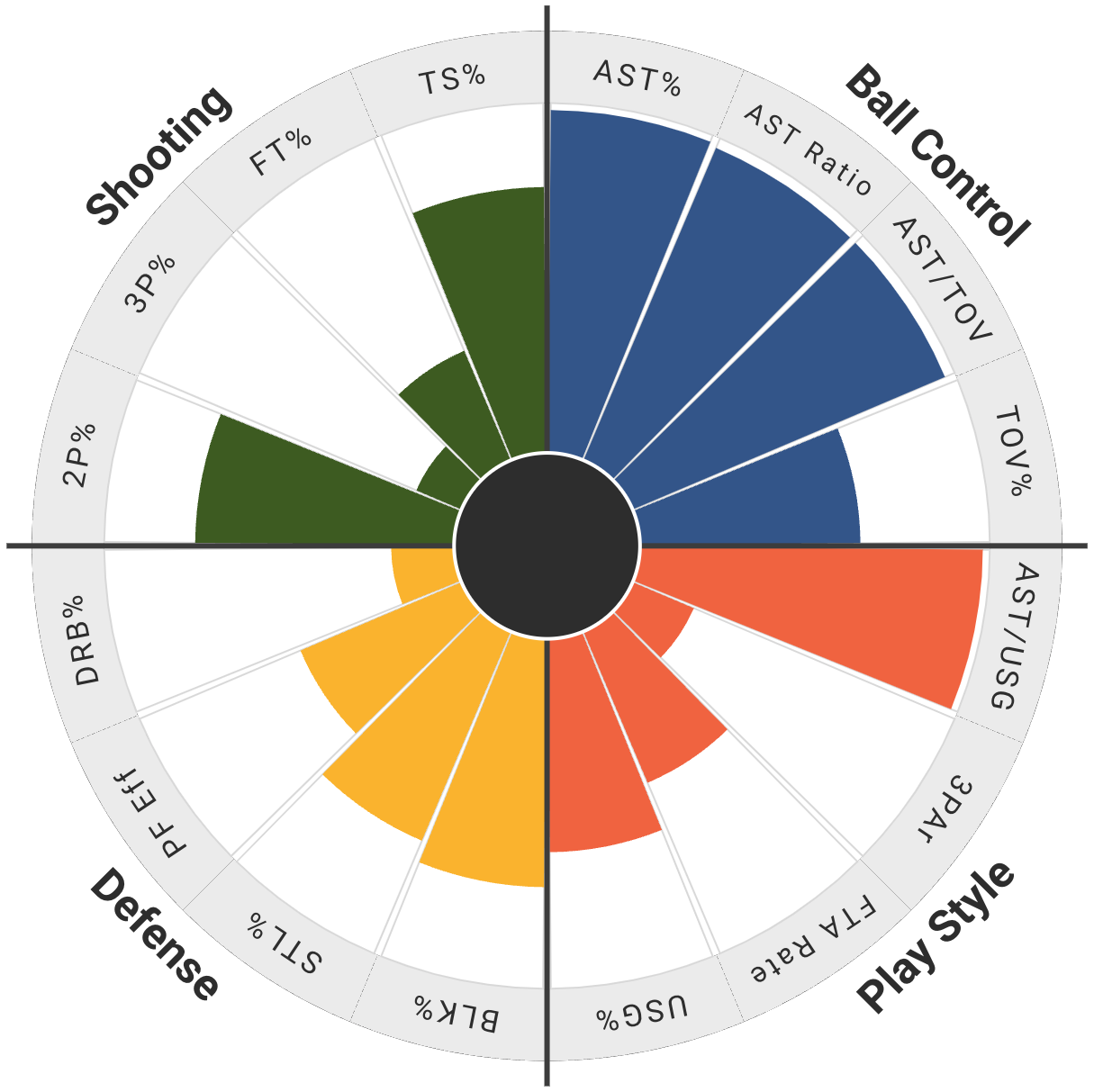
Retriever Betting Thoughts
Like Maine, UMBC is due for plenty of close-game positive regression.
The Retrievers finished the conference season with a positive point differential despite a 6-10 record. They went 2-10 in AmEast games decided by six points or less.
They built significant momentum at the end of last season. The returning production can compete with anyone on any given night.
That said, there’s a good shot the defense holds them back.
Running a four-guard lineup means you’re small, and the Retrievers' interior defense was next-to-non-existent last year. They were dominated by opposing post players (.98 PPP allowed, 10th percentile), allowed the second-most paint points per game in the conference (39) and couldn’t rebound anything.
The Retrievers tried to run a more compact shell defense and ran well with opposing 3-point shooting variance (30%) despite allowing the second-highest 3-point rate in the league. I’m hesitant to believe that won’t regress.
All that said, ShotQuality – which grades defensive metrics based on the “quality” of shots taken and allowed – projected UMBC’s underlying defense much better than its results.
And perhaps that positive regression hit them during the late-season rally. The Retrievers posted a 110.2 Defensive Rating last year. That number dropped to 105.8 across their final 10 games and 97.3 over their final five.
I still think it’s far too easy to stroll into UMBC’s interior and bank in a layup. That won’t change unless Odunowo and Weber State transfer Louie Jordan become good-to-great high-usage rim protectors.
Albany Great Danes
Albany came this close last year.
A heroic Sebastian Thomas performance (31 points on 11-for-16 shooting) had the eight-seeded Danes leading the top-seeded Catamounts at Patrick Gymnasium in the first round of the conference tournament with under a minute left. Alas, TJ Long made another colossal shot, and the upset wasn’t meant to be.
That performance somewhat encapsulates Albany. The Great Danes are a high-variance team with electric talent that can compete with anyone on their best day and lose to anyone on their worst.
Albany lost three studs from last year’s squad, including Thomas, and boasts the second-fewest returning minutes in the conference (28%). Fourth-year head coach Dwayne Killings brought in nine new players this year, and he may end up starting four transfers.
There's a shot that the floor falls out. Killings is 34-60 in his three years with the Great Danes, so it’s tough to imagine he’ll take a rag-tag team of newcomers and make real strides.
On the other hand, they’ve got the best transfer class in the conference. There are some genuine weapons, including a few returning playmakers.
Besides, Albany was the eight-seed last year with the worst defense in the conference. It can’t get worse, right?
Let’s talk about the returning guy – Amar’e Marshall is a budding superstar. He’s in the mix for Conference Player of the Year.
He averaged 17 points per game last year while shooting 37% from deep. He was also the team’s best defender by DBPR, grading out well in spot-up (.67 PPP allowed, 92nd percentile) and isolation (.63 PPP allowed, 75th percentile) situations.
He was one of three explosive off-the-bounce three-level scoring Danes last season. But without Thomas and Tyler Bertram stealing possessions, Marshall could be a legit 20-point-per-game guy — especially in Albany's super-up-tempo offense.
I do wonder if he’ll regress with even higher usage. His .77 assist-to-turnover ratio does worry me. But he has so much potential as a pure-scoring combo guard.
"The first step for him is maturing," Killings tells The Action Network in an interview. "We’re focusing on three areas for his growth: leadership, defensive intensity and decision-making. Teams will give him different coverages this year, and he needs to be able to read those situations. That kind of stuff is the next layer of growth for him."
Regarding other returnees, I’ve always had a soft spot for Aaron Reddish, who I think has talent and could shine as a sixth man.
I also think there’s some potential for former America East Rookie of the Year Justin Neely, a talented back-to-the-basket scorer and dominant defensive rebounder who's struggled with injuries the past few years. The Danes played much slower when Neely earned his ROY award, and his game isn’t exactly suited for Albany’s new hyper-tempo scheme.
Still, he’s an intriguing undersized big man.
But let’s get into the meat of the Danes – the four-player D-I transfer class.
Alcorn State transfer Byron Joshua will likely man the point guard position. He has some pop off-the-bounce and is a shifty change-of-pace guard. He’ll never score much or efficiently, but he’s a high-usage facilitator and crafty passer.
In theory, he’s the perfect guy to set the table for all the Danes' scorers in Killings’ up-tempo, rim-running system.
Video via Synergy Sports.
He's been turnover-prone, and I worry that as he speeds up the pace – Alcorn is a slower, more half-court-oriented offense – he’ll see an uptick in mistakes.
"Byron has some untapped talent and potential because [Alcorn State] played so much in the half-court," Killings says. "But he's got speed — he's a blur. He can push the tempo, strike quickly in transition, or get downhill quickly in a high ball screen. He's learning to play faster."
St. Joe’s transfer Kacper Klaczek projects as Albany’s most impactful player by EvanMiya’s BPR metric (+1.69). He was highly touted as a freshman and flashed signs of greatness as a sophomore, including a four-game December/January stretch where he averaged 14/5/2 with two stocks on 72%/40%/85% shooting splits.
The metrics are fuzzy, mainly because of a down year last season. Still, he’s massive at 6-foot-8, 220 pounds, yet surprisingly mobile, loves to get downhill, and – as is so crucial at Albany – loves to score at the rim and in transition.
He also has a smooth shooting stroke, and I’m holding out some hope for the career 25% 3-point shooter.
Sultan Adewale figures to get in the frontcourt mix as a blue-collar glue guy. The 6-foot-8 Iona transfer isn’t much of an offensive threat, but he’s a monster as a rim protector and offensive rebounder.
But the real X-Factor on the squad is DeMarr Langford.
He’s a 6-foot-5, 220-pound, athletic-as-hell, strong-as-an-ox guard. That alone makes him a potential nightmare matchup for AmEast defenders. He’s also a former four-star, top-100 national prospect who started 30 games for Boston College and averaged a legit 11/5/2 in the ACC just three years ago.
He was very efficient running ball-screens for the Eagles (.87 PPP, 77th percentile) and similarly promising in more limited transition possessions (1.17 PPP, 75th percentile). He can’t huck it from deep, but he’s a strong finisher with a decent mid-range bag, and he seldom turned the ball over.
Injuries set him back at UCF, but his upside potential in a low-major league is almost impossible to fathom.
"He's a guy that can do everything from the free-throw line down," Killings says of Langford. "He can be an all-league player for us."
Two JUCO transfers will factor into guard depth off the bench, Kheni Briggs from Indian Hills and Damon Strand from Raritan Valley. Killings is also reasonably high on freshman big man Ma’Kye Taylor, who he expects to become a “high-level player” right away.
Offensively, I think Killings is trying to make Albany like Bryant. There’s a ton of versatility, length, athleticism and pure talent, and Killings is giving his players more freedom to hunt transition opportunities, exploit isolation mismatches and pressure the rim like crazy.
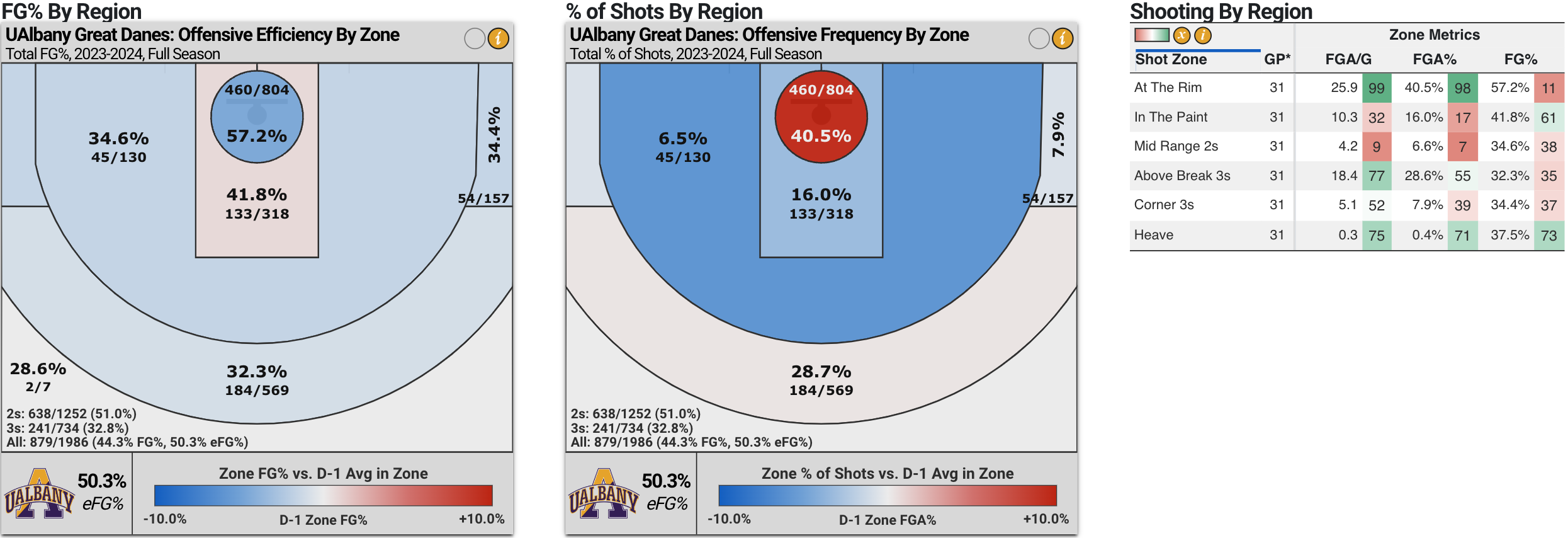
The Danes have the roster construction to play like a Bryant.
Defensively, there are significant issues to address.
When big man Jonathan Beagle left the program in mid-last season, Killings was forced to start playing the 6-foot-7 Reddish as a small-ball center. The results were devastating.
The Danes allowed 44 paint points per game over their final 10, including over 50 in losses to Binghamton and Lowell. By season’s end, the Danes allowed the most at-the-rim field goal attempts of any team nationally, and opponents shot over 65% on those attempts.

The Danes’ small-ball mismatch-hunting lineup was dangerous offensively, but they couldn’t overcompensate enough for a total lack of rim protection or interior defense.
They ran a lot of drop-coverage principles with Beagle early in the year, which helped with denying 3-point opportunities. But they eventually had to switch back to more on-the-level ball-screen coverage principles with Reddish and sank to eighth in the AmEast in Open 3 Rate allowed.
“We struggled to get defensive stops because we didn’t have the personnel we wanted,” Killings says. “In the portal, we focused on bringing in versatile, gritty players. Our physical makeup is much better this year, more like it was in my first year when we had a better defensive team.”
Vertical size remains an issue, but there’s more depth, switchability, overall frame, athleticism and defensive potential.
Plus, Killings might tweak some things to improve his shot at stopping opposing offenses. I read about a potential 1-3-1 zone look with Marshall or Reddish scampering around the top.
“We’re going to try some different things and will show a lot of different lineups,” Killings says. “We’ll still predominantly play man-to-man, but we'll do some different things like extend pressure and slow the game down at times."
I can’t say if it’ll work, but different can only mean better in this context.
Great Dane Betting Thoughts
This is the long-shot future bet to make in the America East Conference.
The talent, length and athleticism are worth buying at a minimum. The Danes could be a gritty two-way team that’s very tough to match up with. They have a proven AmEast star in Marshall, a potential AmEast superstar in Langford and several other guys with untapped potential.
This squad has a ton of potential variance, but you want to target high-variance teams in long-shot futures because the 99th-percentile outcome is obscenely high. Among the three AmEast sleepers, the Danes have the widest range of potential outcomes. Anything can happen if the transfers hit.
For what it’s worth, Bart Torvik ranks Albany as the second-most talented roster in the conference. KenPom’s preseason rankings have Albany as the fourth-best team.
The downside is also significant.
This mixed bag of players includes a lot of injury history and unproven capabilities.
All the Danes want to do is attack the rim, but I don’t see much shooting on the squad, and that could expose them from a spacing perspective.
I also wonder if they’ll be able to rebound more effectively than last year, especially if they mix in more zone defense.
I'm even more worried that the 5-foot-10 Joshua and his 5-foot-10 freshman backup, Amir Lindsey, will be consistently targeted and isolated on the defensive end. Joshua spent too much time defending in isolation last year (17.4% frequency, 95th percentile) and struggled mightily (.90 PPP allowed, 34th percentile).
Still, at 30-to-1 or better, I’m throwing the Danes a bone.
The America East Cellar
Binghamton Bearcats
Levell Sanders can coach.
Last season was the first time since 2009 that the Bearcats posted a .500 record. Between 2011 and 2021, Binghamton averaged seven wins per season, cratering with a 2-29 record in 2012, 3-27 in 2013, and 4-14 in 2021.
Sanders won 12 games in his first year, 13 in his second year, and 15 last year, which deserves praise. Binghamton is a tough job, and the guy has shapeshifted his roster countless times to squeeze every ounce of production he can get out of his players.
The players like him. He had zero transfer out of the program, pulled in an intriguing five-man transfer class, and – most importantly – kept Tymu Chenery and Gavin Walsh in the building.
Chenery is the dude to build around this season. He’s a 6-foot-6 wide-framed, big-bodied wing-forward hybrid who shot 62% from inside the arc but can step out and hit 30% of his triples as a stretch four. He was invaluable as a rim-runner in Binghamton’s cut-heavy scheme last season, scoring 15 points per game, nine paint points per game and generating 1.35 cutting PPP (74th percentile).
Video via Synergy Sports.
He also cleans the boards well and adds nearly two blocks per game. He’s a real high-usage two-way weapon on the wing.
Walsh exploded down the stretch last year, averaging 10/8 with a steal per game on 52% shooting from inside the arc across the Bearcats’ final six regular-season games, eventually earning a spot on the All-Conference Freshman team. He’s built like Chenery – a 6-foot-7 two-way interior force on the wing – although he’s less of a threat from behind the arc and swipes more balls than he swats.
In Chenery and Walsh, Sanders has two legit wings to build around this year. I’d also watch Chris Walker and Evan Ashe, who could take a step forward in the wing rotations.
The problem is that the Bearcats lost a ton of production to graduation. Point guard Symir Torrence and his seven assists per game are gone. Dan Petcash and Armon Harried’s combined 21 points per game are gone. Tariq Balogun and his elite interior defense are gone.
And aside from Chenery and Walsh, those minutes are falling into unproven hands.
I’m most worried about the point guard replacement. Torrence was among the nation’s best facilitators, and he perfectly executed Binghamton’s cut-heavy scheme. The Bearcats led the nation in cutting frequency and ranked fourth in at-the-rim shot frequency.
The replacement options are Masud Stewart, who has logged 200 total minutes over the past two seasons, and Jayden Lemond, who averaged nine minutes per game in his freshman year at William & Mary.
Stewart is considered a pure scorer, while Lemond is a penetrate-and-dish guy. But neither is proven, and they’re attempting to replace a certified stud.
That said, Sanders will likely adjust his offense away from the cut-heavy scheme he utilized so much last season. Last year's lack of shooting really bothered him, so he went out and snagged a few potential marksmen in the portal.
I adore the portal grab of Jackson Benigni, a two-guard from Stonehill. He was a killer in the Skyhawks’ motion-based offense, scoring in double-digits 15 times, peaking with a 27-point effort in a mid-January game against Fairleigh Dickinson. He also poured in 21 against Lowell in a November non-conference game.
Dominic Capriotti was the Southland Rookie of the Year last season at Houston Christian after shooting 39% from 3 on nearly five attempts per game. Ben Callahan-Gold is a 6-foot-8 stretch big man from D-III transfer Trinity College who averaged 16/6 last year on 36% shooting from 3.
“Not a lot of five men in our league play the way he plays,” Sanders told Blue Ribbon when asked about Callahan-Gold. “He’s 6-foot-8, but he moves like a guard. You can run him off of staggers, pin downs, flare screens that I think will cause problems.”
I think that gives us a good idea of what Binghamton’s offense might look like this year. In theory, Lemond’s ability to drive and dish — combined with an army of new shooting threats — will create a more perimeter-oriented offense than last year’s rim-reliant one.
“Jayden is really good at getting into the paint and finding guys,” Sanders said, again to Blue Ribbon. “We need that guy to get into the paint, collapse the defense, kick out for guys that can make shots.”
Blue Ribbon writer Ryan Restivo continued: "In his three seasons, Sanders has tried to adjust each year to what his group can bring to the table and is starting to sense this group can create better spacing to attack."
It's also worth mentioning that Sanders called out Stewart's work ethic during America East Media Day while highlighting Lemond's. I can't be sure, but I'm a betting man, and I'd be willing to wager that Jayden gets the start against Penn State on Nov. 4.
Still, basketball isn’t played in theory. I can’t be sure how things will shake out on that end of the floor.
The defense is similarly challenging to gauge. Sanders’ disciplined, switchable man-to-man scheme was among the league’s best in 2022 and 2023, primarily because they contested everything on the perimeter, allowing low-quality 3s and keeping opponents’ eFG% down.
That flipped last year, as Binghamton sank to eighth in the AmEast in 3-point defense (33%) and seventh in efficiency.
It could be because while Balogun was a top-tier post-up and interior defensive anchor, he was vulnerable defending out in space, so Sanders started running a more conservative shell defense.
It also could be that while Chenery and Walsh are mobile two-way wings, neither grades out well by the defensive metrics, especially when closing out on spot-up opportunities.
The more likely explanation is simple unluckiness. The Bearcats still ranked 21st nationally in Low Quality 3s Allowed, so ShotQuality projected them closer to a 32% 3-point defense than the 35% they surrendered throughout the year.
Regardless, Nehemiah Benson will play a monster role as the Balogun replacement at the five. I’m rather intrigued by his upside. He started scoring in droves toward the end of the season, pouring in 10 paint points per game on 67% shooting from the field across his final five starts. He's sneaky incredible in transition (1.58 PPP, 97th percentile), highlighting his potential athleticism.
Video via Synergy Sports.
He doesn’t grade out as an elite interior defender like Balogun, but he’s a little more laterally mobile and might be a better fit for Sanders’ typical system. It's also worth considering whether his offensive upside justifies his defensive downside.
| Player | ORtg Diff – ON | DRtg Diff – ON | Net Rtg Diff – ON |
|---|---|---|---|
| Balogun | -6.4 (99.9 vs 106.3) | -3.0 (107.8 vs 110.8) | -3.4 |
| Benson | +6.7 (106.2 vs 99.5) | +3.3 (110.8 vs 107.5) | +3.4 |
Bearcat Betting Thoughts
Binghamton will look a lot different this year.
The offense will look overhauled, and the defense will look adjusted.
Bearcat basketball will shift to the next generation of leaders, Chenery chief among them.
Sanders will likely tweak this thing all year long.
Still, after a few years of slowly building, I’m projecting regression in 2025.
I just think they’re downgrading significantly at the guard and forward spots. Again, basketball isn’t played in theory, and the Bearcats are replacing Symir "seven-assist" Torrence for two guards with almost zero D-I experience.
I like Benson, but Balogun was an elite interior defender and rim protector. Benson can easily get bullied by the league’s more physical, skilled forwards.
Video via Synergy Sports.
Meanwhile, Callahan-Gold was an average post-up defender at the D-III level, which can’t bode well for a step up in competition.
I like the wings, but I am unsure about their all-around defensive capabilities. It's also worth mentioning how critical Petcash and Harried were last year. Petcash was the team's best player by BPR and on-off net rating splits (+9.2).
The only way I see program progression is for Binghamton to take and make a million more 3s. But again, the only transfer who has played “big” minutes at the D-I level is Benigni, who shot just 32% from deep last season.
I’ve seen some love for Binghamton in the media, with some polls ranking the Bearcats as high as fourth in the America East. But the metrics have them much lower, as they rank seventh in KenPom’s priors, eighth in Torvik’s and eighth in EvanMiya’s.
The bullish case is that Torrence and Balogun held this team back — Torrence in the shooting and defense departments and Balogun in the all-around offense department — and leaning into Chenery's leadership and Benson's versatility will produce better results. The on-off splits for Torrence-Balogun lineups compared to Chenery-Benson lineups seem to support that.
| Player Combination | Net Rating – ON | Net Rating – OFF |
|---|---|---|
| Torrence-Balogun | -11.1 (101.8 ORtg, 112.8 DRtg) | -4.4 (107.6 ORtg, 112.0 DRtg) |
| Chenery-Benson | -3.2 (108.6 ORtg, 111.8 Drtg) | -13.8 (88.8 ORtg, 102.6 Drtg) |
Still, Binghamton is firmly in my bottom tier until proven otherwise.
New Hampshire Wildcats
Year 2 for Nathan Davis could get tricky.
He won 26 games in Year 2 at Bucknell, but it’s hard to see him making another double-digit-win jump with the fewest returning minutes in the conference (28%). The Wildcats also lost their high-usage point guard, Ahmad Robinson, and last year’s Conference Player Of The Year, Clarence Daniels.
But Davis doesn’t think it’s all bad.
“We can play faster,” Davis tells The Action Network in an interview. “We ranked 25th in the country in pace last year, but we really only had Ahmad, Trey [Woodyard] and Rex [Sunderland] handling the ball and pushing the pace. We have more guys who can do that now — the parts will be more interchangeable, which will allow us to go from backcourt to frontcourt quicker."
Considering New Hampshire jumped 304 spots in tempo year-over-year, it’s hard to imagine the Wildcats make another considerable jump. But it’s not such a crazy idea.
Daniels was a stud. A true three-level scoring big man who could fill it up from anywhere. But he was a ball-stopper. Without him, the Wildcats can lean into Davis’ pace-and-space offense more, perhaps even leaning into more ball-screen motion stuff in the half-court.
“It’s not about shooting faster overall, though,” Davis says. “We talk a lot about putting pressure on the defense the entire time we have the ball. If we score at the rim, hit a three, or get fouled within the first six seconds, we’ll do that. If it takes 24 seconds, that’s fine too. We want to make sure they guard us the whole time.”
Woodyard and Sunderland are the primary returnees.
I like Woodyard. The 6-foot-6 swingman is an excellent shooter (37% from 3 last year), a willing passer (10% assist rate with few turnovers) and dynamic in transition (1.35 PPP, 90th percentile). He’s worthless on defense (more on that later), but Sunderland evolved into a rather good POA defender, holding his own against ball-screen creators and secondary scorers.
"He's very efficient," Davis says of Woodyard. "He's a guy that's going to make open shots, can put the ball on the floor, finish at the rim, and play with his back to the basket."
Sunderland doesn’t offer much offensively, but I’m very intrigued by JUCO transfer Sami Pissis, who should get considerable run at point. He averaged 12/5 at Chipola while nabbing two steals per game. His shooting is up for debate.
“Sammy will be one of the point guards we’ll use,” Davis says. “Jawarie [Hamelin] will also play there. Rex and Trey could move to that spot if needed."
The backcourt is a mixed bag, but I see where the contributions come from. The frontcourt is a mystery. I’m unsure how the Wildcats replace the production of Daniels and Jaxson Baker.
“I don’t have those answers yet,” Davis says regarding his frontcourt rotations. “We lost a lot of guys, but we needed to upgrade the roster anyway, and I feel we've done that."
Some combination of Dylan Saunders, Giancarlo Bastianoni, Anthony McComb III and Emmanuel Okpomo will man the four and five spots.
I think Saunders is the “safest” bet to make legitimate frontcourt contributions, given he’s a decent stretch four option who canned nearly 31% of his 50 3s at Iona last year.
Okpomo joins from Temple, and he’s shown flashes of defensive upside in limited minutes. He’s massive at 6-foot-10, 225 pounds, and he played 14 ACC games with Wake Forest a few seasons ago.
“We liked him on film for his ability to guard one-on-one and run the floor,” Davis says. “He’s really improved his footwork in the post."
Bastianoni posted 9/4 on 58% shooting at D-II North Georgia last year. He posted gaudy interior efficiency marks with the Nighthawks, pouring in 1.4 post-up PPP (99th percentile) and 1.48 cutting PPP (90th percentile).
I liked the tape I saw on him, and I think he will make contributions at this level.
Video via Synergy Sports.
There’s not much tape on him, but Davis is uber-high on Bowling Green transfer McComb.
“He’s probably one of our top two or three players,” Davis says. “He’s really dynamic."
Wildcat Betting Thoughts
Admittedly, I don’t have a great feel for the 2025 Wildcats.
I know they’ll play faster and use more ball handlers, but will that lead to better shots? The Wildcats run in transition more than almost any college basketball team, but they ranked below average in transition PPP (1.04, 42nd percentile) and were abhorrent at the rim (1.07 PPS, 12th percentile) last season.
Daniels was among the league’s better interior finishers, so how will they adjust without him?
The Wildcats spaced the floor well last year, generating the conference’s highest Rim-and-3 Rate. But they seldom generated open jumpers — over 60% of their catch-and-shoot opportunities were guarded, so they flailed in spot-up opportunities.
And outside of Woodyard, there aren't many marksmen on this year's roster.
The roster construction feels more physically imposing. As Davis tells me, “We weren’t as big or as strong as we needed to be last year – we’re bigger, better, more talented and more physical across the board this year.”
But last year’s defense was horrific.
The biggest issue was interior defense. Daniels was a decent interior defender, but Woodyard and Baker were obliterated in post-up sets. The Wildcats were the conference’s second-worst 2-point defense (55%). None of the incoming big men transfers grade out well in that regard.
| Player | Post-up PPP Allowed (%ile) |
|---|---|
| Dylan Saunders | 1.00 (33rd) |
| Emmanuel Okpomo | 1.25 (7th) |
| Giancarlo Bastianoni | 1.15 (12th) |
| Anthony McComb | N/A (Not Qualified) |
The perimeter defense saved them through January, as the Wildcats held their own against ball screens and were a top-20 3-point defense nationally. But that was mostly smoke and mirrors, as they ranked last in the conference in 3-point rate allowed and got uber-lucky against unguarded jumpers (.88 PPP allowed, 99th percentile).
The regression monster sacked them in February. The Wildcats lost their final four regular-season games because UMBC, Albany, Binghamton and Vermont canned 42 of their 100 3-pointers, a 42% rate more characteristic of their defensive efforts.
Ultimately, I don’t see where improvements come from. I don’t see it with the Wildcats. This is a wildly inexperienced roster with unproven transfers vying for rotational minutes. Only Sunderland and Woodyard have averaged over 10 minutes per game at the D-I level.
There’s a good shot New Hampshire will sink to the AmEast basement in 2025. That Nov. 9 game against UConn should be a bloodbath.
NJIT Highlanders
Everyone is counting NJIT out.
The Highlanders won’t be good, but I’m not sure they’ll be the worst team in the conference by season’s end.
For starters, they have a budding superstar in Tariq Francis.
Last year’s stat line is shocking. He dropped 15/4/3 with 1.5 steals per game on 35% shooting from deep – all as a true freshman! He won Rookie of the Year honors for his efforts.
But he does so much more than just stuff the stat sheet. He is a positively dominant pick-and-roll initiator in a ball-screen-centric offense, scoring .95 PPP (84th percentile) on high volume. Despite his small frame (6-foot-0, 180 pounds), he's also a solid defender, especially in isolation (.14 PPP, 100th percentile).
And he performed best in the biggest moments.
From January onward, Francis averaged 19/5/3 with two steals per game. And in a two-game February stretch, Francis dropped 57 points, snagged 15 rebounds, dished out four assists and nabbed three steals while canning seven of 14 3s in wins over Vermont and Lowell.
It was the first time since 2020 that a first-year head coach beat Vermont. That coach, Grant Billmeier, enters Year 2 in Newark with one of the nation’s youngest, inexperienced rosters.
12 of his 14 players are underclassmen, and the other two are grad transfers from the D-II and D-III levels. Among 364 college basketball rosters, the Highlanders rank ahead of only Mercyhurst, The Citadel and VMI in Bart Torvik’s Experience metric.
The other primary returner is 6-foot-7 forward Levi Lawal. He’s limited as a shooter and defender, but he’s an OK roll-man when partnered with Francis, and he was devastating rim-running alongside the young guard.
Sebastian Robinson will run alongside Francis in the backcourt, but he was the Highlanders' worst overall player by BPR last year (-3.59). He needs to take a monster step forward to be effective.
The lower-level transfers are fascinating. Tim Moore Jr. and Triston Wennersten are two 6-foot-6 wings with devastating offensive arsenals.
Moore comes from D-II Benedict College. He's a vertically gifted, positively bouncy interior scorer and lob threat who can pile up points by cutting, posting and getting out in transition. He averaged 15/7 on 57% shooting and could be a real threat rim-running alongside Francis.
Also, he can catch bodies.
Wennersten comes from D-III Ithaca College and is a solid stretch four (40% 3-point shooter). He can be lethal in pick-and-pop sets and boasts a pretty crafty mid-post game. He’ll happily cut off Francis but also has a shot to replace some of last year's Kjell de Graaf roll-man production.
Video via Synergy Sports.
Billmeier wanted to target longer players to generate more interior offense, and these are two potential candidates.
The rest of the roster is a hodge-podge mix of inexperienced underclassmen.
- Jake Goldberg: 6-foot-4 sophomore guard who needs to shoot it better.
- Ari Fulton: 6-foot-7 freshman out of Westover High School. Lengthier athletic wing with a high motor.
- Malachi Arrington: 6-foot-10 freshman center from Immaculate Conception High School.
- Stefan Jimenez-Vojnic: 6-foot-11 freshman forward from Academy of Central Florida. Big, rugged four or five.
- Walt Andrews Jr.: 6-foot-4 combo guard from Hargrave Military Academy.
- John Kelly: 6-foot-8 shooting forward from Rutgers Prep.
- Cameron Piggee: 5-foot-9 redshirt freshman spark-plug bench guard.
- Quentin Duncan: 6-foot-5 reclassified freshman shooter.
- Eyal Nankin: 6-foot-7 sophomore frontcourt depth piece.
Highlander Betting Thoughts
A team as young as this will struggle early on. It might take months for the youth to settle into D-I ball, and the non-conference won’t be kind to the Highlanders.
Defense is the big Achilles' heel. Francis is solid but undersized, and Robinson is a sieve at the two. Wennerson and Moore didn’t grade out well defensively at the lower levels, so they likely won’t in the AmEast. There’s zero rim protection, and the Highlanders leave too many shooters unguarded.
However, they have a young superstar two-way guard and ball-screen maestro leading the charge. They have some super interesting offensive pieces in the frontcourt. And you never quite know what you’re getting with freshmen.
Billmeier’s grand plan is more long-term. But this year, the key is putting the right players in the right roles and rounding out the rotation around Francis.
Call me crazy, but I fully expect an uber-young roster with a second-year head coach to improve immensely throughout the season. I think the ceiling is a tad higher than most are ready to believe.
Honestly, this team reminds me a ton of UMBC from last year — a young, new roster that could come together nicely as long as the head coach puts the puzzle together. Billmeier is a Kevin Willard disciple, so I like his chances.
The Highlanders will take plenty of punches and put up plenty of underwhelming performances, but they could be a super dangerous squad come February and March.
I’m looking to fade NJIT in the non-conference, but there will be plenty of late-season spots to bet the Highlanders as big ‘dogs. They stepped up huge against the league’s top last February.
I’ve already circled the Feb. 27 home game against Vermont, as the Catamounts will be in a sleepy spot following a monster late-season, potentially-title-clinching match against UMass Lowell.
However, do I think they're as good as Caesars Sportsbook seems to think? Absolutely not!
The fourth-shortest odds in the conference? For a squad that went 3-13 in league play last year and was the only team that missed the conference tournament? That'd be a wild turnaround, even if they didn't have the nation's youngest roster and a lifeless defense. What are we doing here, guys?
That said, if Billmeier keeps this youthful bunch around Newark for the next two to three years while nurturing internal progression, the Highlanders could close in on a potential fourth-place finish before 2030.
But that’s past my purview.
Tanner McGrath's America East Predictions & Picks
Futures Long-Shot Wager
- AmEast Regular Season Winner: Albany Great Danes (+4000, Caesars)
Conference Power Ratings
- Vermont
- UMass Lowell
- Bryant
- Albany
- Maine
- UMBC
- NJIT
- Binghamton
- New Hampshire
Conference Player of the Year
- Earl Timberlake, Bryant
Conference Defensive Player of the Year
- Ileri Ayo-Faleye, Vermont
Conference Sixth Man of the Year
- Shy Odom, Vermont
Conference Newcomer of the Year
- DeMarr Langford, Albany
Conference Rookie of the Year
- Martin Somerville, UMass Lowell
Conference Coach of the Year
- John Becker, Vermont
All-Conference First Team
- G Shamir Bogues, Vermont
- G Marcus Banks, UMBC
- G Amar'e Marshall, Albany
- G Tariq Francis, NJIT
- G/F Earl Timberlake, Bryant
- F Max Brooks, UMass Lowell
All-Conference Second Team
- G DeMarr Langford, Albany
- G Kellen Tynes, Maine
- F Shy Odom, Vermont
- F Quinton Mincey, UMass Lowell
- F Cam Morris, UMass Lowell
All-Conference Third Team
- G TJ Hurley, Vermont
- G TJ Long, Vermont
- G/F Rafael Pinzon, Bryant
- F Connor Withers, Bryant
- F Ileri Ayo-Faleye, Vermont


